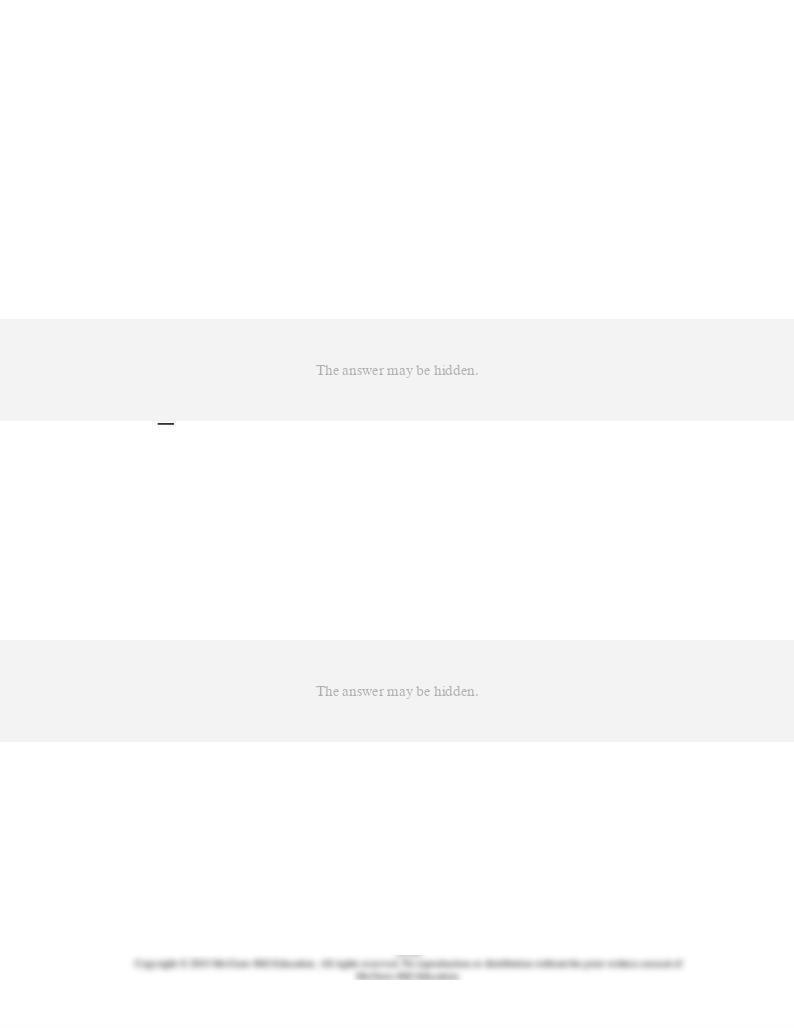
Chapter 12 Pure Monopoly Answer Key
Multiple Choice Questions
1.
One feature of pure monopoly is that the firm is:
AACSB: Analytic
Accessibility: Keyboard Navigation
Blooms: Remember
Difficulty: 1 Easy
Learning Objective: 12-01 List the characteristics of pure monopoly.
Topic: An Introduction to Pure Monopoly
2.
One defining characteristic of pure monopoly is that:
AACSB: Analytic
Accessibility: Keyboard Navigation
Blooms: Remember
Difficulty: 1 Easy
Learning Objective: 12-01 List the characteristics of pure monopoly.
Topic: An Introduction to Pure Monopoly

3.
Which phrase would be most characteristic of pure monopoly?
A.
Close substitutes
B.
Efficient advertiser
C.
Price taker
D.
Sole seller
AACSB: Analytic
Accessibility: Keyboard Navigation
Blooms: Remember
Difficulty: 1 Easy
Learning Objective: 12-01 List the characteristics of pure monopoly.
Topic: An Introduction to Pure Monopoly
4.
The classic example of a private unregulated monopoly is:
A.
Coca Cola
B.
Wham-O (Frisbee)
C.
General Motors
D.
General Electric
AACSB: Analytic
Accessibility: Keyboard Navigation
Blooms: Understand
Difficulty: 2 Medium
Learning Objective: 12-01 List the characteristics of pure monopoly.
Topic: An Introduction to Pure Monopoly
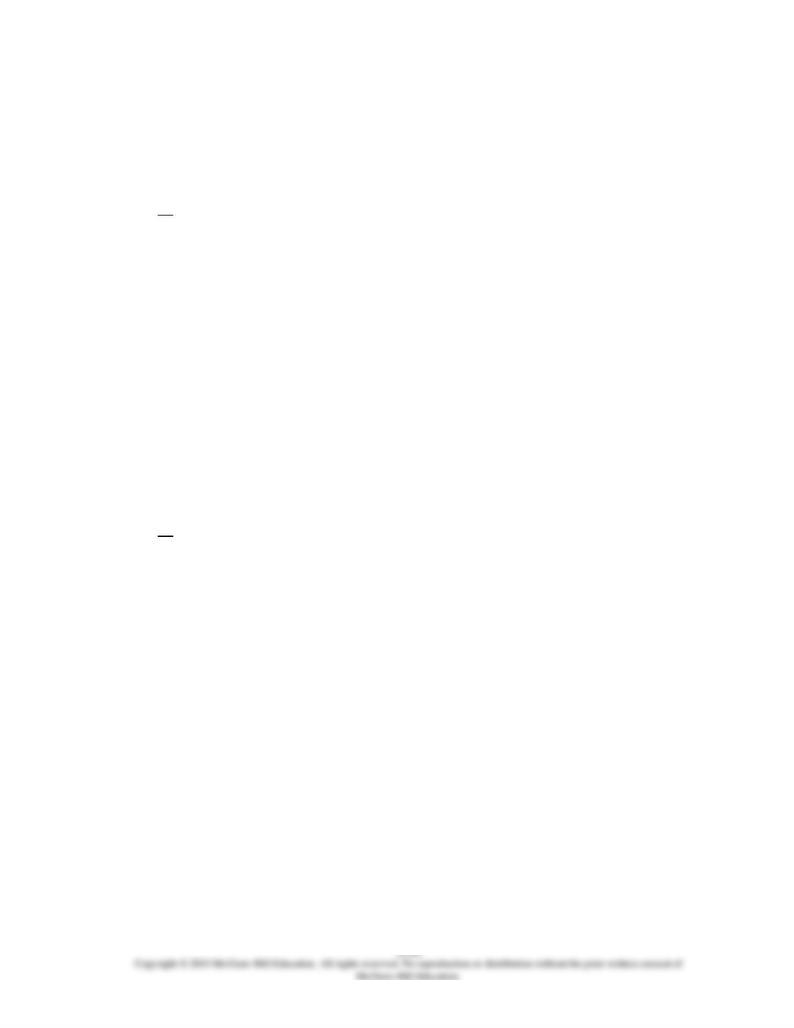
5.
One major barrier to entry under pure monopoly arises from:
A.
The availability of close substitutes for a product
B.
Ownership of essential resources
C.
The price taking ability of the firm
D.
Diseconomies of scale
AACSB: Analytic
Accessibility: Keyboard Navigation
Blooms: Remember
Difficulty: 1 Easy
Learning Objective: 12-02 List and explain the barriers to entry that shield pure monopolies from competition.
Topic: Barriers to Entry
6.
Barriers to entry:
A.
Usually result in pure competition
B.
Can result from government regulation
C.
Exist in economic theory but not in the real world
D.
Are typically the result of wrongdoing on the part of a firm
AACSB: Analytic
Accessibility: Keyboard Navigation
Blooms: Remember
Difficulty: 1 Easy
Learning Objective: 12-02 List and explain the barriers to entry that shield pure monopolies from competition.
Topic: Barriers to Entry
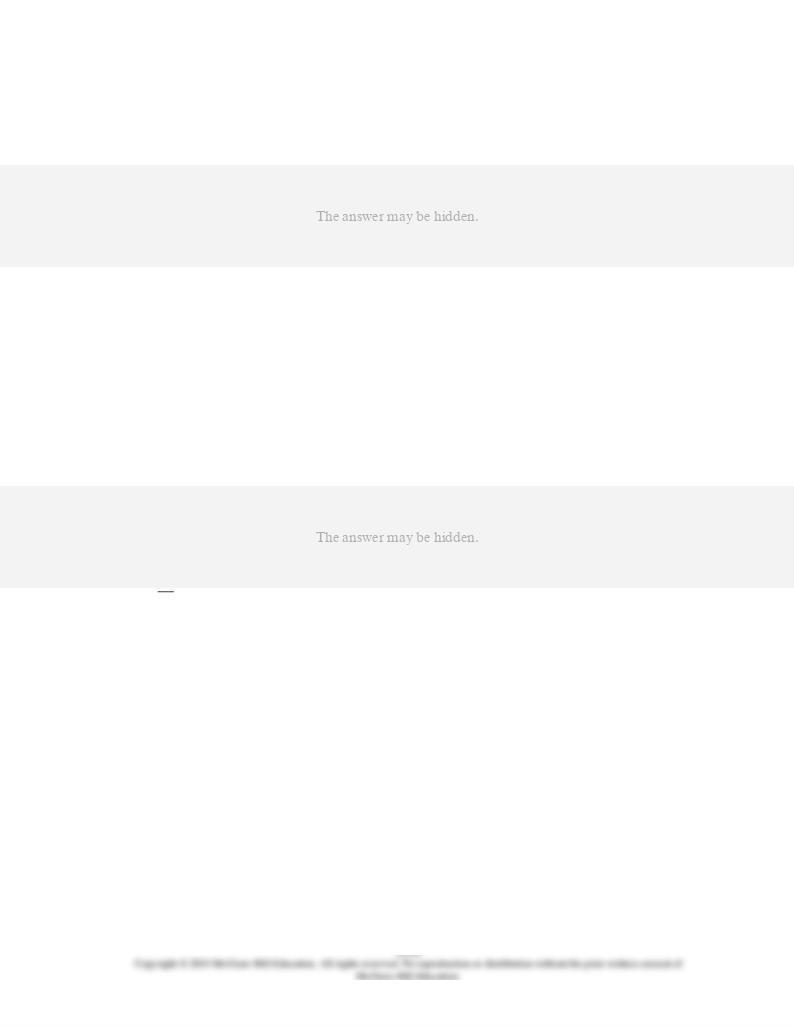
7.
Which of the following is a barrier to entry?
AACSB: Analytic
Accessibility: Keyboard Navigation
Blooms: Remember
Difficulty: 1 Easy
Learning Objective: 12-02 List and explain the barriers to entry that shield pure monopolies from competition.
Topic: Barriers to Entry
8.
A monopoly is most likely to emerge and be sustained when:
AACSB: Analytic
Accessibility: Keyboard Navigation
Blooms: Understand
Difficulty: 2 Medium
Learning Objective: 12-02 List and explain the barriers to entry that shield pure monopolies from competition.
Topic: Barriers to Entry
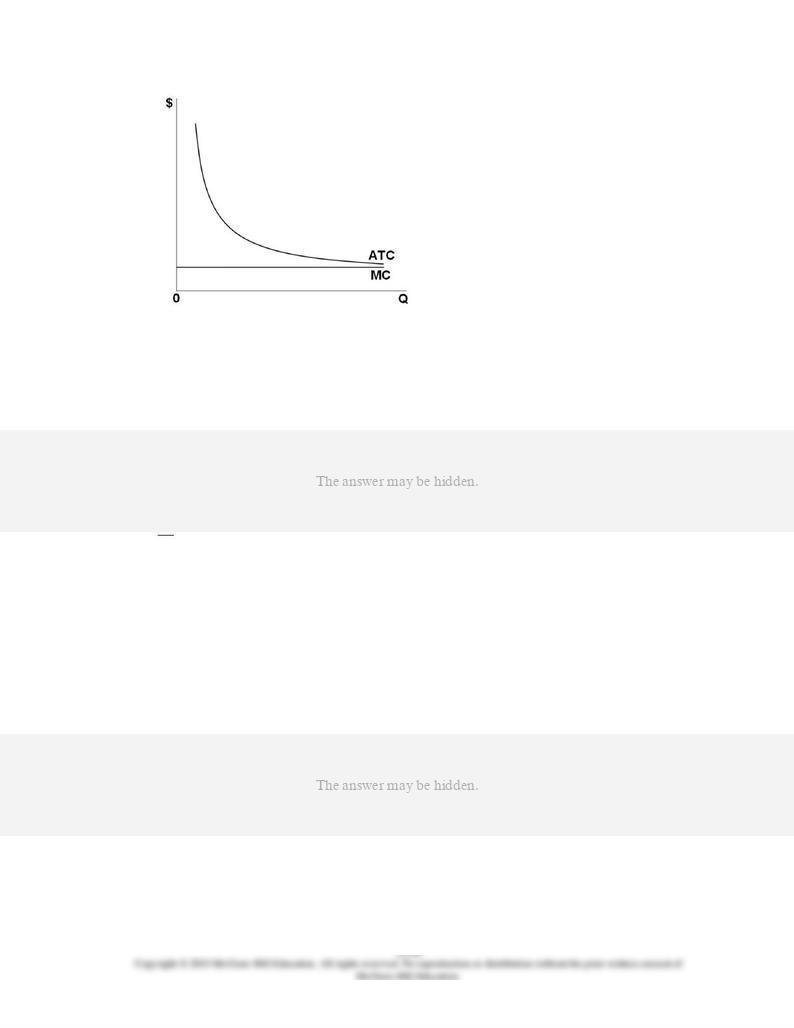
9.
A firm that has the long-run cost curves shown in the graph above would
be able to do or have the following,
except
:
AACSB: Analytic
Blooms: Understand
Difficulty: 2 Medium
Learning Objective: 12-02 List and explain the barriers to entry that shield pure monopolies from competition.
Topic: Barriers to Entry
10.
Natural monopolies result from:
AACSB: Analytic
Accessibility: Keyboard Navigation
Blooms: Understand
Difficulty: 2 Medium
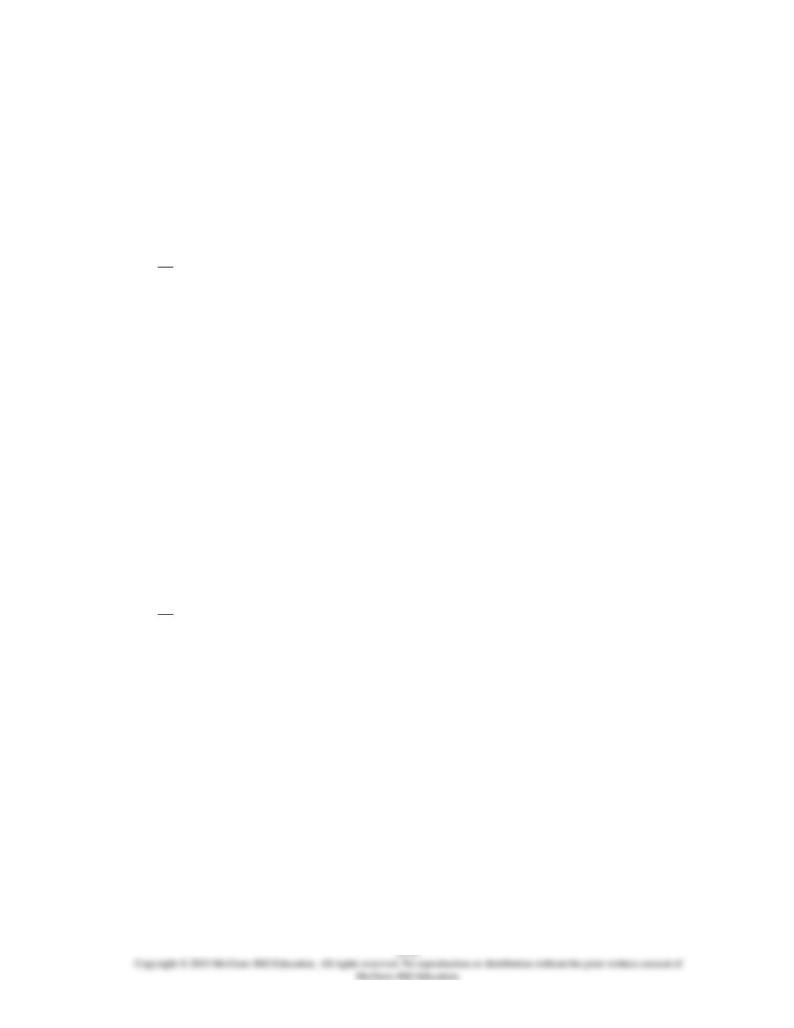
Learning Objective: 12-02 List and explain the barriers to entry that shield pure monopolies from competition.
Topic: Barriers to Entry
11.
Which of the following is
not
a barrier to entry in an industry?
A.
Economies of scale
B.
Profit maximization
C.
Strategic pricing
D.
Government licensing
AACSB: Analytic
Accessibility: Keyboard Navigation
Blooms: Remember
Difficulty: 1 Easy
Learning Objective: 12-02 List and explain the barriers to entry that shield pure monopolies from competition.
Topic: Barriers to Entry
12.
In many large U.S. cities, taxicab companies operate as near monopolies
because of:
A.
Patents
B.
Licenses
C.
Economies of scale
D.
Strategic pricing
AACSB: Analytic
Accessibility: Keyboard Navigation
Blooms: Remember
Difficulty: 1 Easy
Learning Objective: 12-02 List and explain the barriers to entry that shield pure monopolies from competition.
Topic: Barriers to Entry

13.
An exclusive legal right as sole producer for 20 years granted to an inventor
of a product is called a:
AACSB: Analytic
AACSB: Communication
Accessibility: Keyboard Navigation
Blooms: Remember
Difficulty: 1 Easy
Learning Objective: 12-02 List and explain the barriers to entry that shield pure monopolies from competition.
Topic: Barriers to Entry
14.
One feature of pure monopoly is that the demand curve:
AACSB: Analytic
Accessibility: Keyboard Navigation
Blooms: Remember
Difficulty: 1 Easy
Learning Objective: 12-03 Explain how demand is seen by a pure monopoly.
Topic: Monopoly Demand

15.
The non-discriminating pure monopolist must decrease price on all units of
a product sold in order to sell more units. This explains why:
AACSB: Analytic
Accessibility: Keyboard Navigation
Blooms: Remember
Difficulty: 1 Easy
Learning Objective: 12-03 Explain how demand is seen by a pure monopoly.
Topic: Monopoly Demand
16.
The demand curve confronting a non-discriminating pure monopolist is:
AACSB: Analytic
Accessibility: Keyboard Navigation
Blooms: Remember
Difficulty: 1 Easy
Learning Objective: 12-03 Explain how demand is seen by a pure monopoly.
Topic: Monopoly Demand
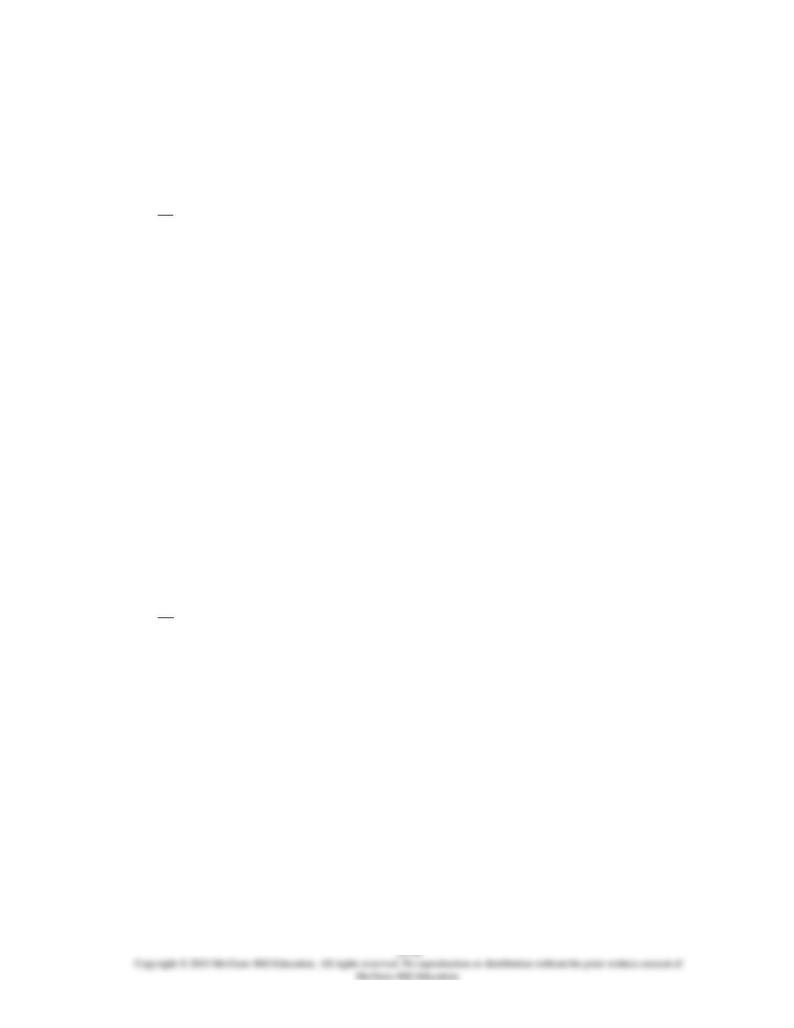
17.
Under pure monopoly, a profit-maximizing firm will produce:
A.
In the inelastic range of its demand curve
B.
In the elastic range of its demand curve
C.
Only where marginal costs are decreasing
D.
Only where marginal revenue is increasing
AACSB: Analytic
Accessibility: Keyboard Navigation
Blooms: Remember
Difficulty: 1 Easy
Learning Objective: 12-03 Explain how demand is seen by a pure monopoly.
Topic: Monopoly Demand
18.
Given a downward-sloping linear demand curve, if total revenue decreases
as quantity rises, marginal revenue must be:
A.
Positive and demand is elastic
B.
Negative and demand is elastic
C.
Positive and demand is inelastic
D.
Negative and demand is inelastic
AACSB: Analytic
Accessibility: Keyboard Navigation
Blooms: Understand
Difficulty: 2 Medium
Learning Objective: 12-03 Explain how demand is seen by a pure monopoly.
Topic: Monopoly Demand
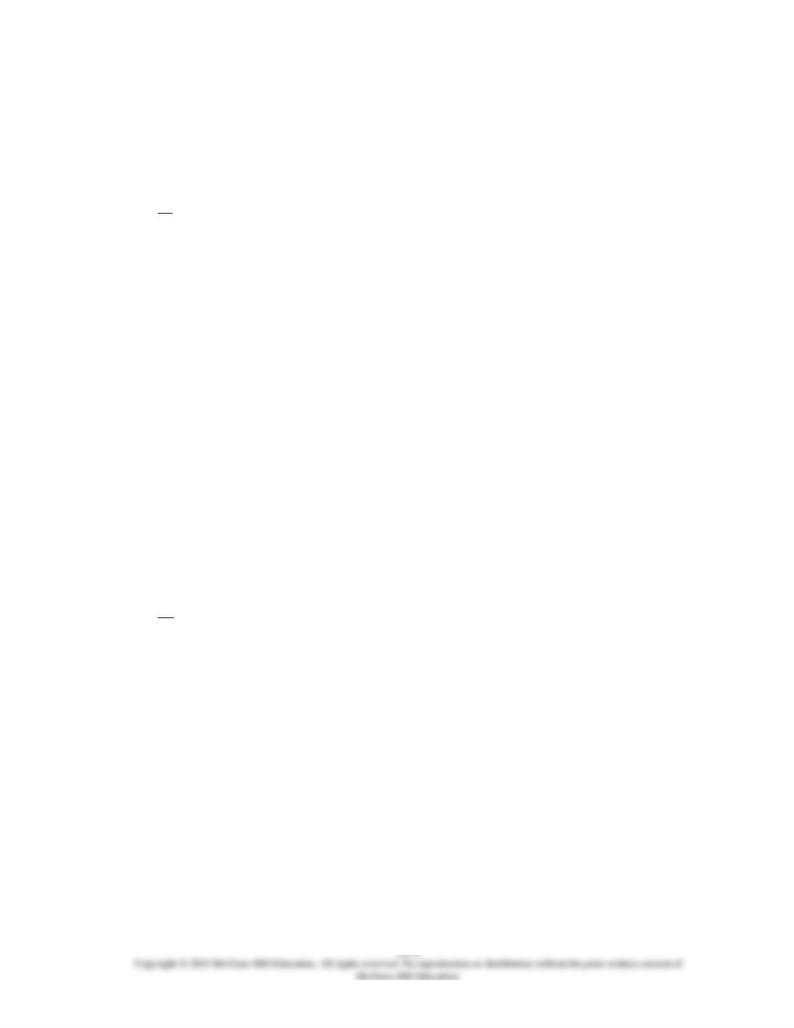
19.
Given a linear demand curve, at which combination of price and marginal
revenue (
P
, MR) is the price elasticity of demand greater than 1?
A.
P
= 15, MR = 8
B.
P
= 12, MR = 0
C.
P
= 8, MR = -2
D.
P
= 4, MR = -4
AACSB: Analytic
Accessibility: Keyboard Navigation
Blooms: Analyze
Difficulty: 3 Hard
Learning Objective: 12-03 Explain how demand is seen by a pure monopoly.
Topic: Monopoly Demand
20.
A non-discriminating monopolist will find that marginal revenue:
A.
Exceeds average revenue or price
B.
Is identical to price
C.
Is sometimes greater and sometimes less than price
D.
Is less than average revenue or price
AACSB: Analytic
Accessibility: Keyboard Navigation
Blooms: Remember
Difficulty: 1 Easy
Learning Objective: 12-03 Explain how demand is seen by a pure monopoly.
Topic: Monopoly Demand

21.
Assume that a monopolist faces a linear demand curve. If the firm is
operating at an output level where marginal revenue is positive, the firm:
AACSB: Analytic
Accessibility: Keyboard Navigation
Blooms: Apply
Difficulty: 2 Medium
Learning Objective: 12-03 Explain how demand is seen by a pure monopoly.
Topic: Monopoly Demand
22.
Assume that a monopolist faces a linear demand curve and that it produces
the output quantity where total revenue is maximized. At that output, the
price elasticity of demand for the product is:
AACSB: Analytic
Accessibility: Keyboard Navigation
Blooms: Apply
Difficulty: 2 Medium
Learning Objective: 12-03 Explain how demand is seen by a pure monopoly.
Topic: Monopoly Demand
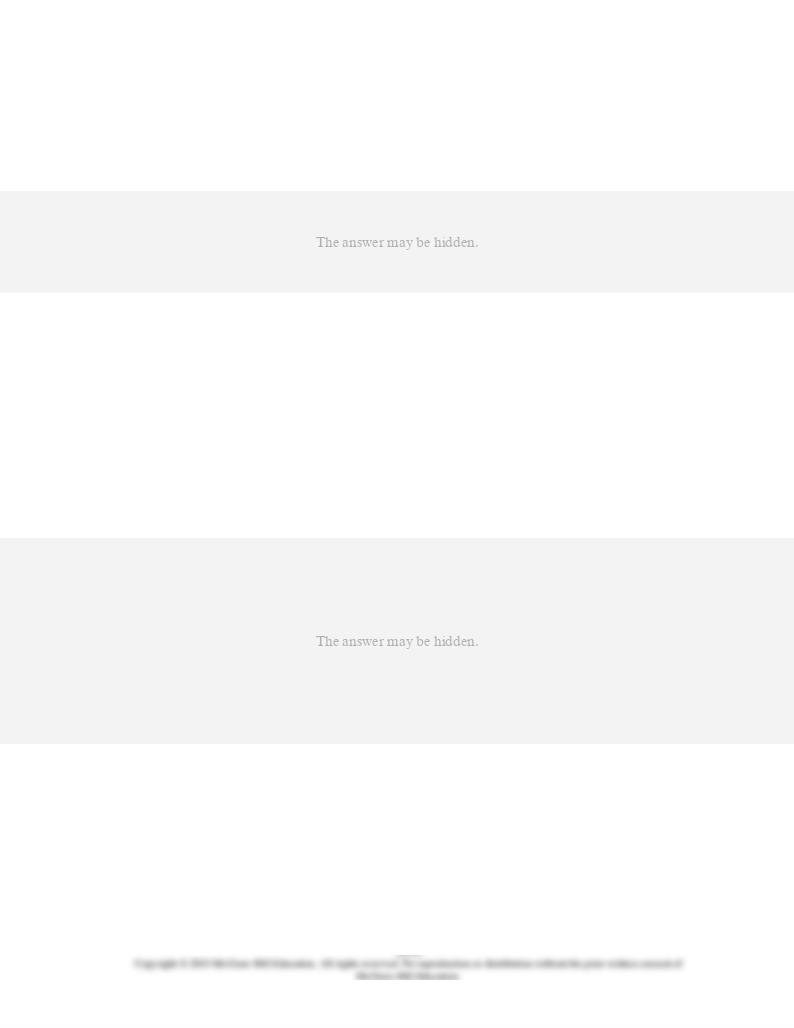
23.
A pure monopoly firm will never charge a price in the inelastic range of its
demand curve because lowering price to get into this region will:
AACSB: Reflective Thinking
Accessibility: Keyboard Navigation
Blooms: Apply
Difficulty: 3 Hard
Learning Objective: 12-03 Explain how demand is seen by a pure monopoly.
Topic: Monopoly Demand
24.
The region of demand in which the monopolist will choose a price-output
combination will be:
AACSB: Analytic
Accessibility: Keyboard Navigation
Blooms: Remember
Difficulty: 2 Medium
Learning Objective: 12-03 Explain how demand is seen by a pure monopoly.
Topic: Monopoly Demand

25.
In the inelastic portion of a monopolist's demand curve, an increase in price
will:
AACSB: Reflective Thinking
Accessibility: Keyboard Navigation
Blooms: Understand
Difficulty: 3 Hard
Learning Objective: 12-03 Explain how demand is seen by a pure monopoly.
Topic: Monopoly Demand
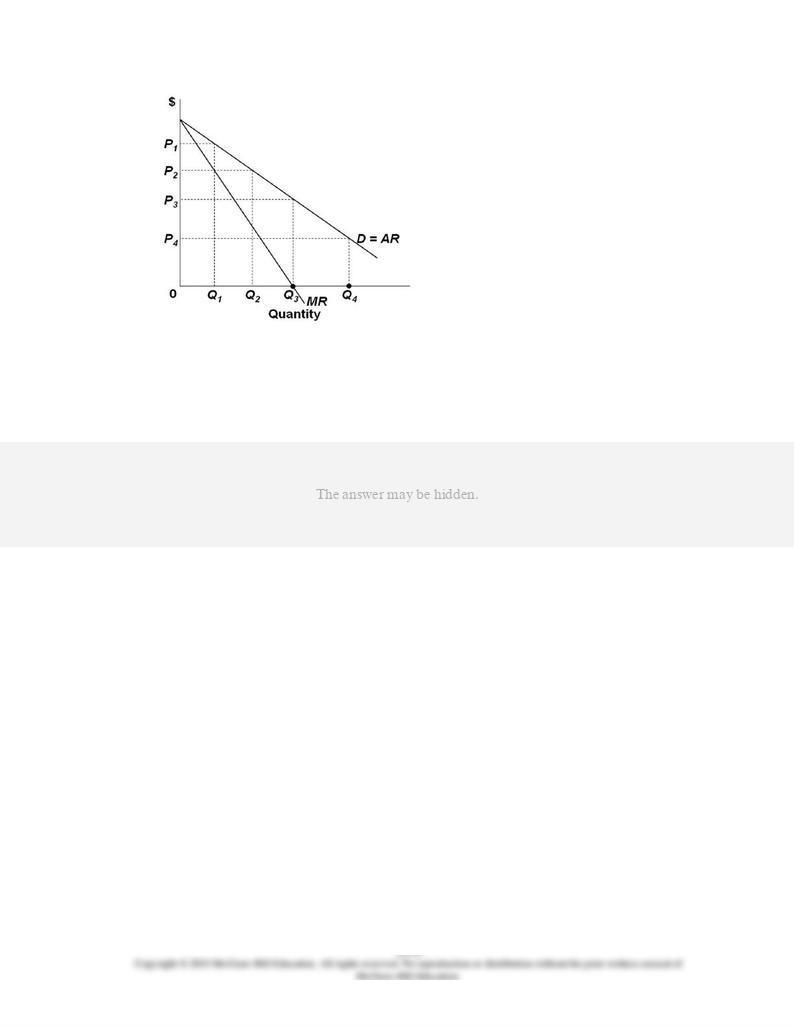
26.
Refer to the above graph showing the revenue curves for a monopolist.
What price should be charged in order to maximize total revenue?
AACSB: Analytic
Blooms: Apply
Difficulty: 1 Easy
Learning Objective: 12-03 Explain how demand is seen by a pure monopoly.
Topic: Monopoly Demand

27.
Refer to the above graph showing the revenue curves for a monopolist.
Total revenue will be greatest at what output level?
AACSB: Analytic
Blooms: Apply
Difficulty: 1 Easy
Learning Objective: 12-03 Explain how demand is seen by a pure monopoly.
Topic: Monopoly Demand
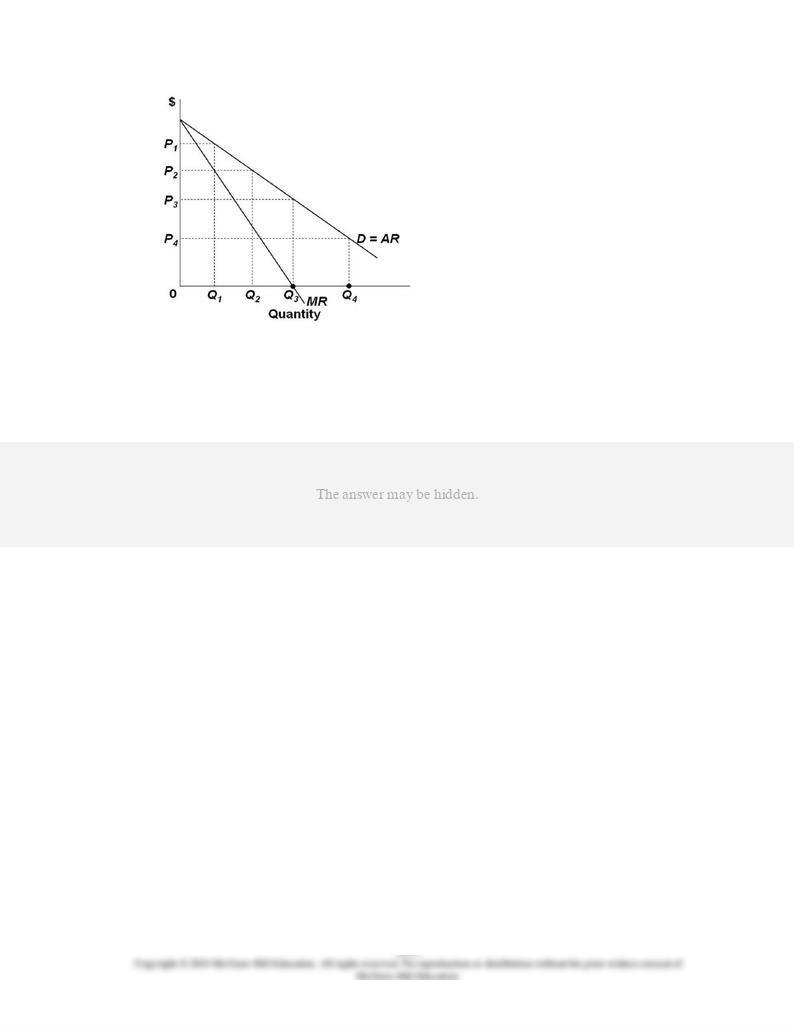
28.
Refer to the above graph showing the revenue curves for a monopolist. The
elastic portion of the demand curve ranges from quantity:
AACSB: Analytic
Blooms: Apply
Difficulty: 1 Easy
Learning Objective: 12-03 Explain how demand is seen by a pure monopoly.
Topic: Monopoly Demand

29.
Refer to the above graph showing the revenue curves for a monopolist. At
what output level is demand inelastic?
AACSB: Analytic
Blooms: Apply
Difficulty: 1 Easy
Learning Objective: 12-03 Explain how demand is seen by a pure monopoly.
Topic: Monopoly Demand

30.
Refer to the above graph showing the revenue curves for a monopolist. If it
wants to sell quantity Q1, it must charge a price:
AACSB: Analytic
Blooms: Remember
Difficulty: 1 Easy
Learning Objective: 12-03 Explain how demand is seen by a pure monopoly.
Topic: Monopoly Demand
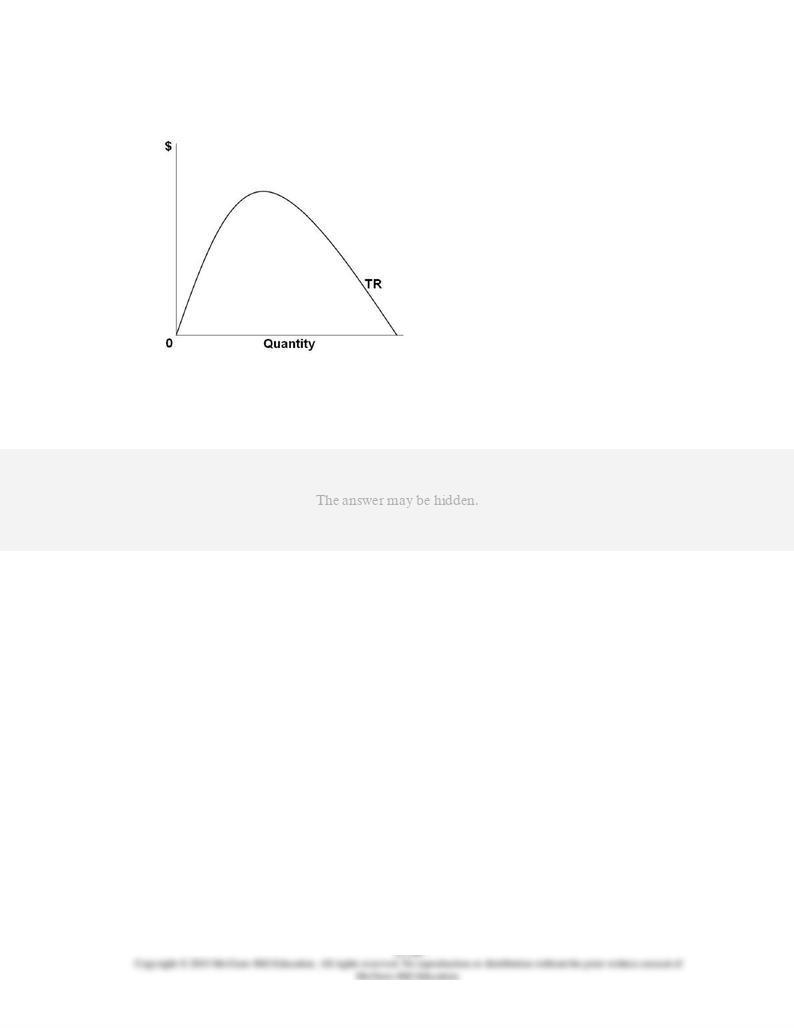
31.
The following graph shows a total revenue curve for a monopolist.
Refer to the above graph. The firm's marginal revenue curve must be:
AACSB: Analytic
Blooms: Apply
Difficulty: 3 Hard
Learning Objective: 12-03 Explain how demand is seen by a pure monopoly.
Topic: Monopoly Demand

32.
The following graph shows a total revenue curve for a monopolist.
Refer to the above graph. When the total revenue curve reaches a
maximum, marginal revenue is:
AACSB: Analytic
Blooms: Apply
Difficulty: 2 Medium
Learning Objective: 12-03 Explain how demand is seen by a pure monopoly.
Topic: Monopoly Demand
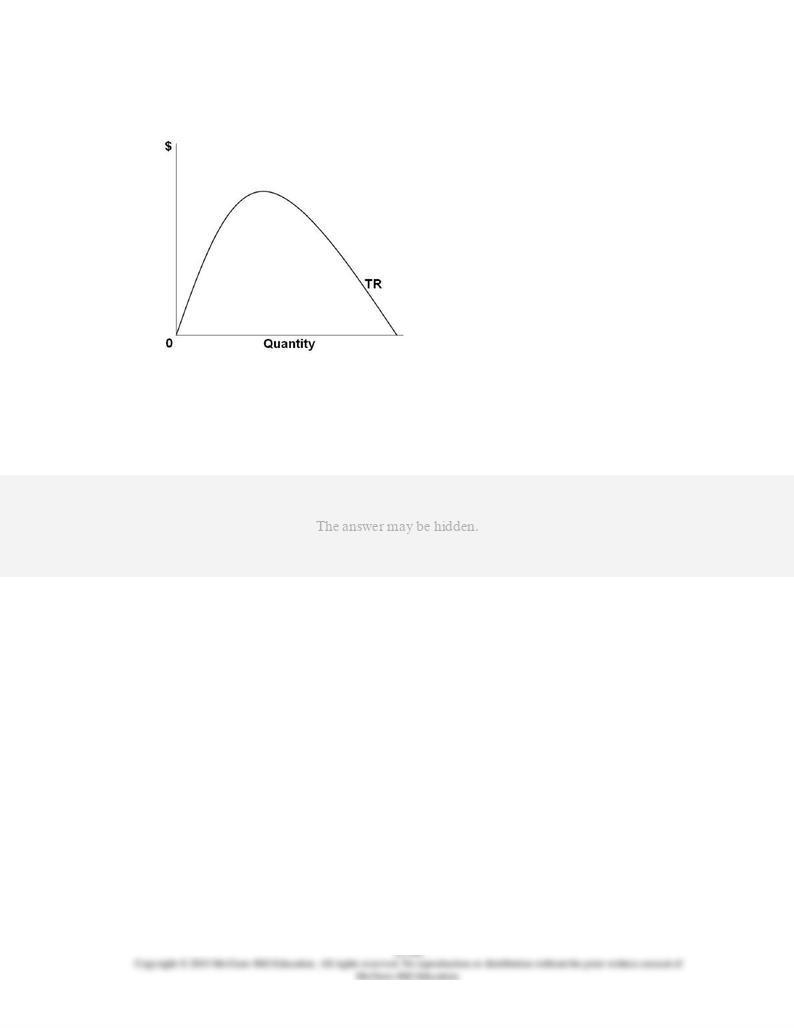
33.
The following graph shows a total revenue curve for a monopolist.
Refer to the above graph. When total revenue declines as output expands,
demand is:
AACSB: Analytic
Blooms: Apply
Difficulty: 2 Medium
Learning Objective: 12-03 Explain how demand is seen by a pure monopoly.
Topic: Monopoly Demand
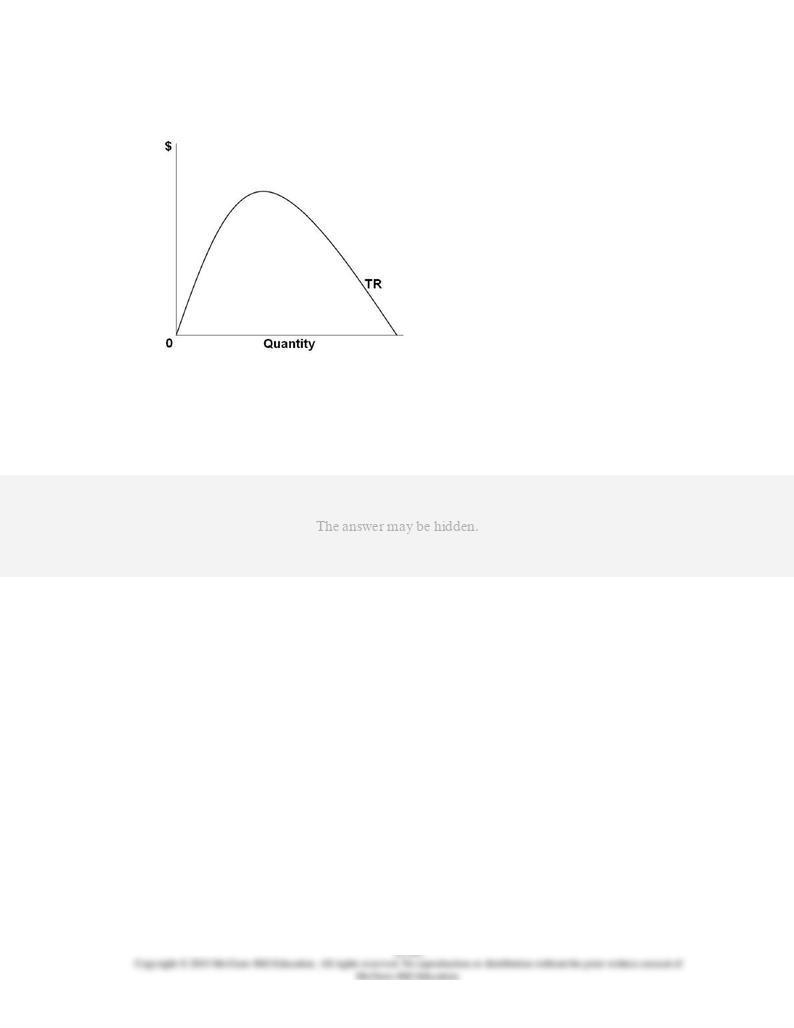
34.
The following graph shows a total revenue curve for a monopolist.
Refer to the above graph. When total revenue falls as output expands,
marginal revenue is:
AACSB: Analytic
Blooms: Apply
Difficulty: 2 Medium
Learning Objective: 12-03 Explain how demand is seen by a pure monopoly.
Topic: Monopoly Demand
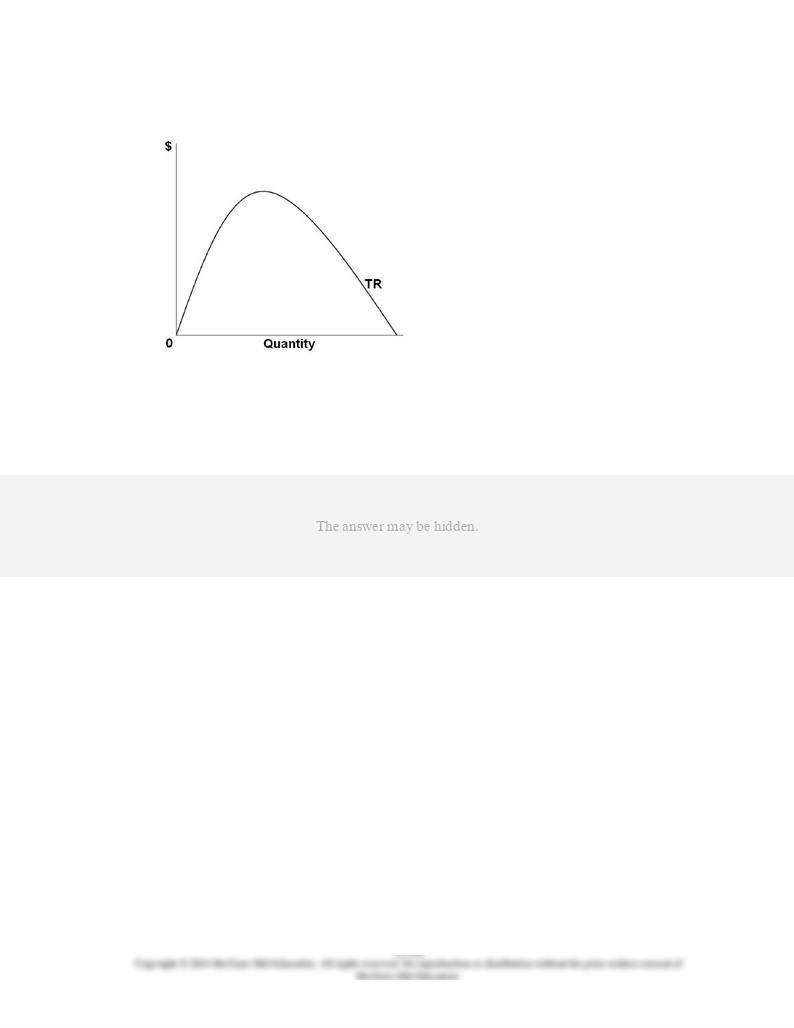
35.
The following graph shows a total revenue curve for a monopolist.
Refer to the above graph. The profit-maximizing firm will produce in that
output level where total revenue is:
AACSB: Analytic
Blooms: Apply
Difficulty: 2 Medium
Learning Objective: 12-03 Explain how demand is seen by a pure monopoly.
Topic: Monopoly Demand

36.
Refer to the above graph showing a linear demand curve for a monopolist.
Which of the following statements is correct?
AACSB: Analytic
Blooms: Apply
Difficulty: 3 Hard
Learning Objective: 12-03 Explain how demand is seen by a pure monopoly.
Topic: Monopoly Demand
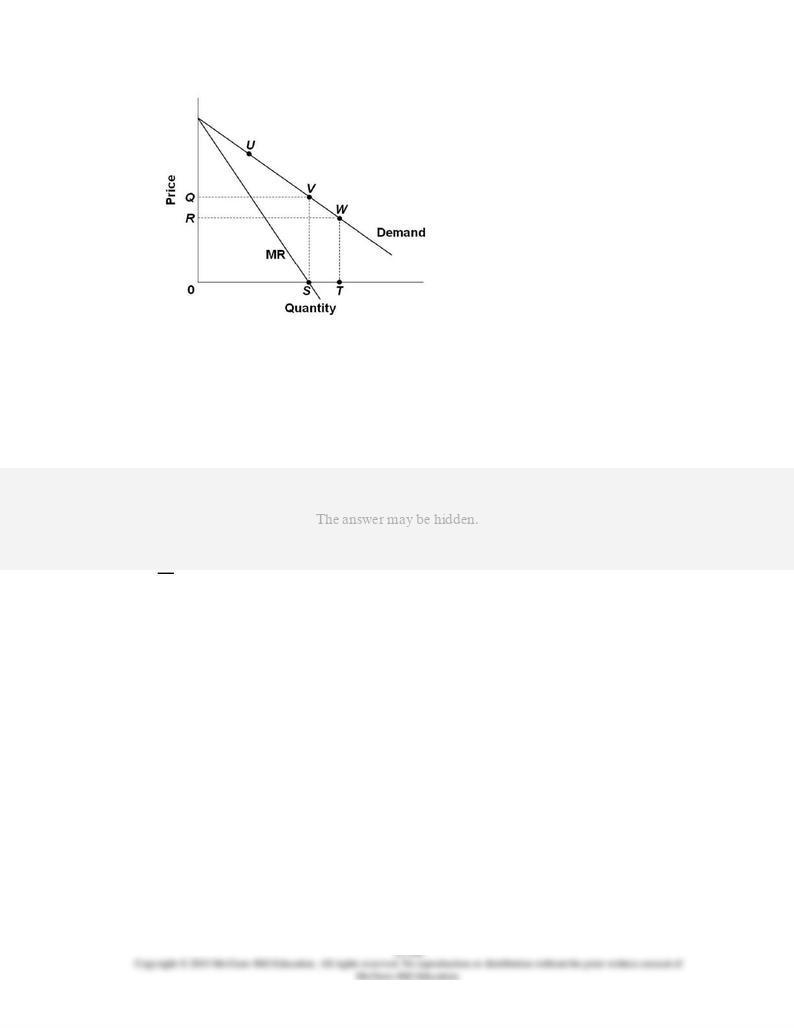
37.
Refer to the above graph showing a linear demand curve for a monopolist.
In which range of the demand curve (or output quantity) will the firm
operate?
AACSB: Analytic
Blooms: Apply
Difficulty: 3 Hard
Learning Objective: 12-03 Explain how demand is seen by a pure monopoly.
Topic: Monopoly Demand
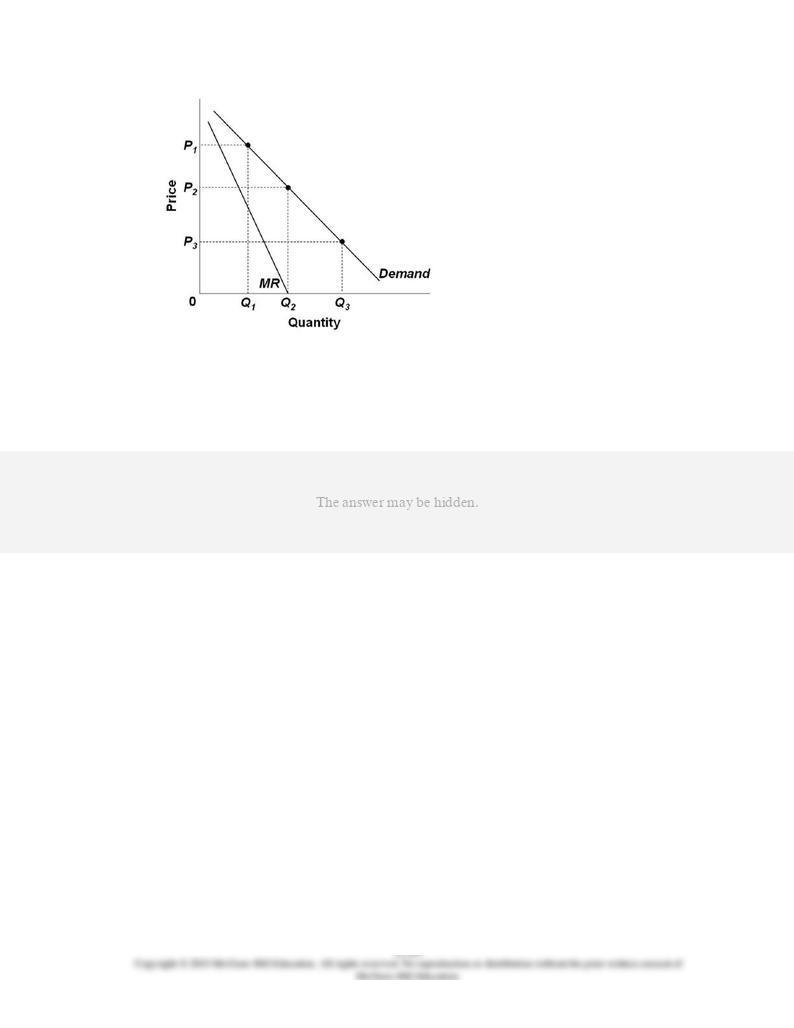
38.
Refer to the above graphs of D and MR for a monopolist. Which of the
following statements is true?
AACSB: Analytic
Blooms: Apply
Difficulty: 2 Medium
Learning Objective: 12-03 Explain how demand is seen by a pure monopoly.
Topic: Monopoly Demand

39.
Refer to the above graphs of D and MR for a monopolist. Which of the
following statements is true?
AACSB: Analytic
Blooms: Apply
Difficulty: 2 Medium
Learning Objective: 12-03 Explain how demand is seen by a pure monopoly.
Topic: Monopoly Demand
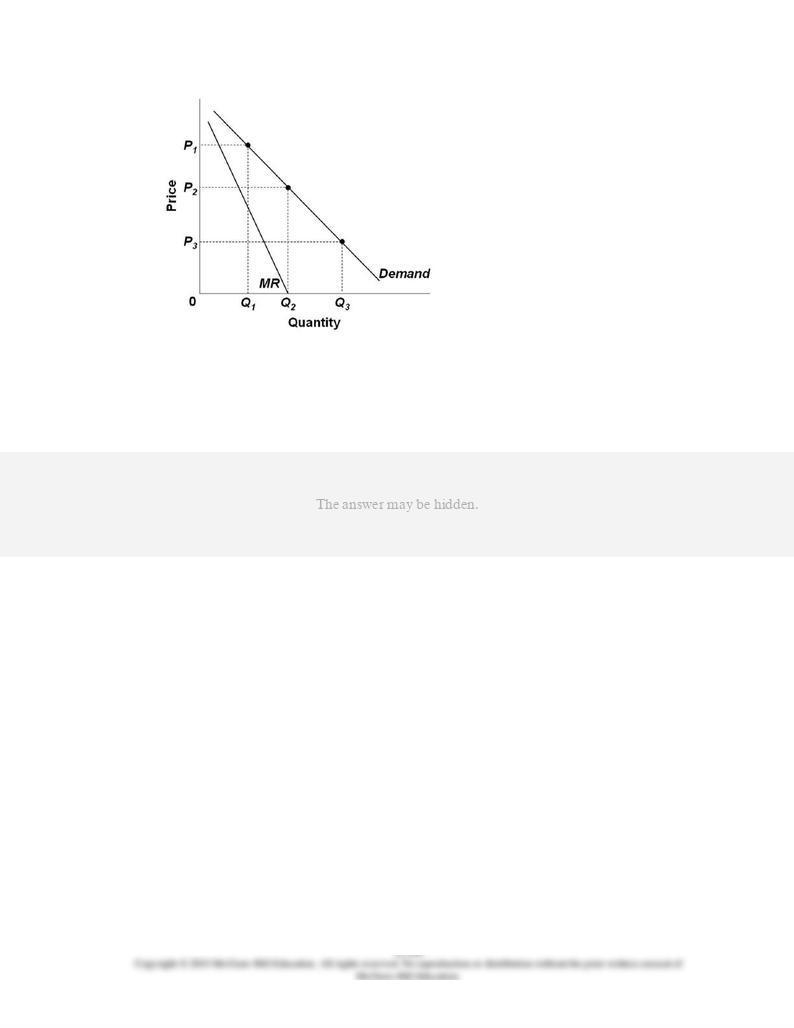
40.
Refer to the above graphs of D and MR for a monopolist. We know that to
maximize profits the firm will set a price:
AACSB: Analytic
Blooms: Apply
Difficulty: 2 Medium
Learning Objective: 12-03 Explain how demand is seen by a pure monopoly.
Topic: Monopoly Demand
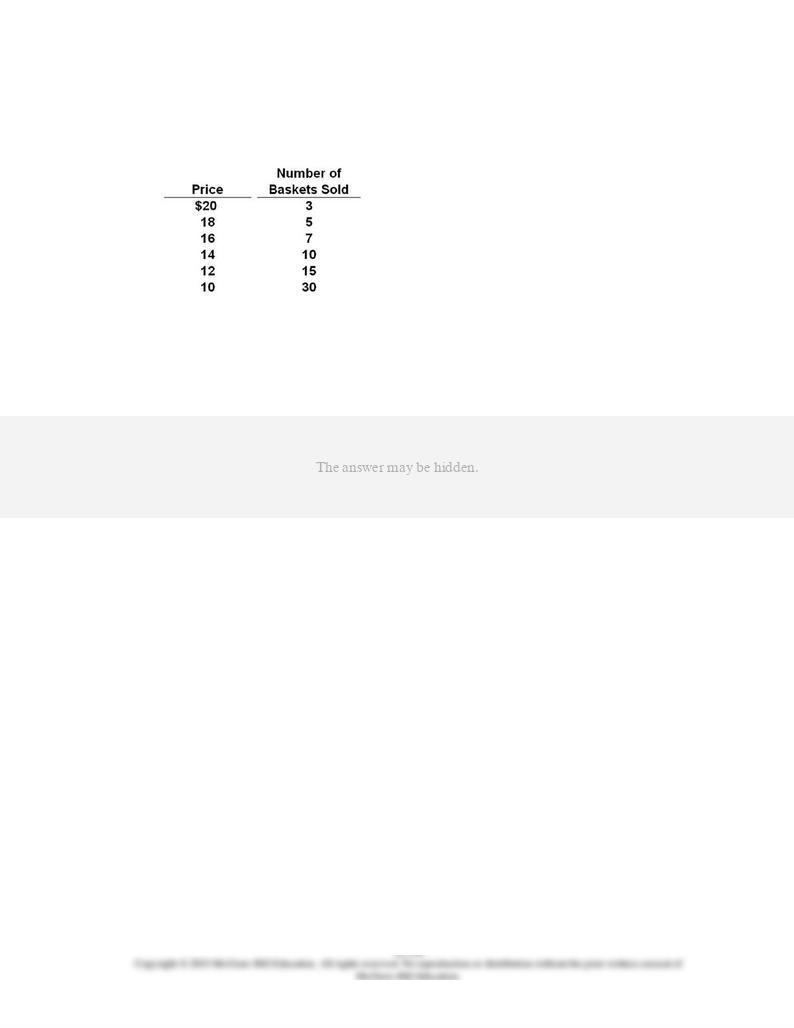
41.
The table shows the demand schedule facing Nina, a monopolist selling
baskets.
Refer to the above table for Nina. What is the change in total revenue if she
lowers the price from $20 to $18?
AACSB: Analytic
Blooms: Apply
Difficulty: 2 Medium
Learning Objective: 12-03 Explain how demand is seen by a pure monopoly.
Topic: Monopoly Demand
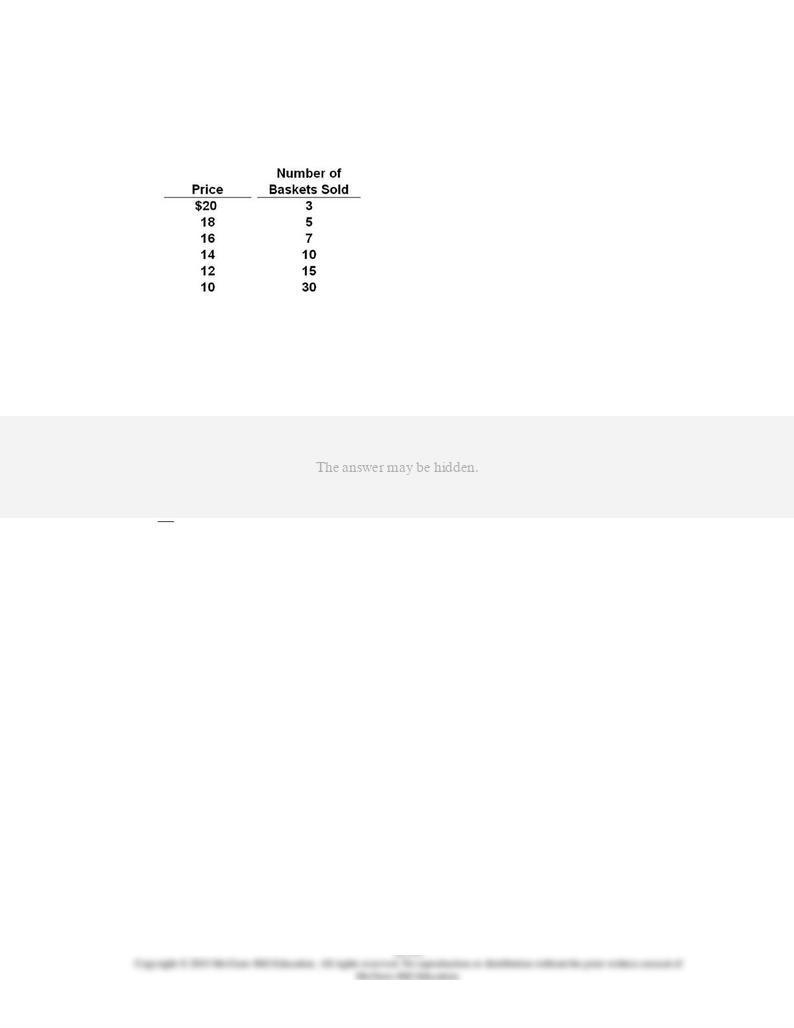
42.
The table shows the demand schedule facing Nina, a monopolist selling
baskets.
Refer to the above table for Nina. What is the change in total revenue if she
raises the price from $10 to $12?
AACSB: Analytic
Blooms: Apply
Difficulty: 2 Medium
Learning Objective: 12-03 Explain how demand is seen by a pure monopoly.
Topic: Monopoly Demand
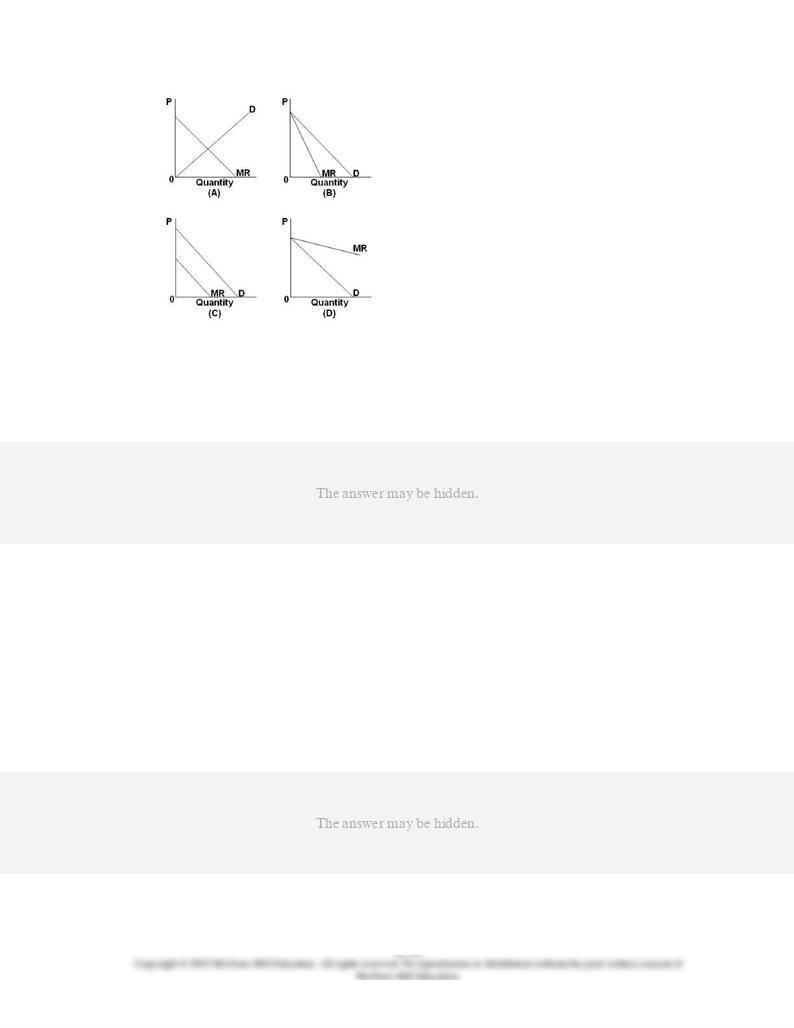
43.
Which of the above shows the correct relationship between demand and
marginal revenue?
AACSB: Analytic
Blooms: Apply
Difficulty: 1 Easy
Learning Objective: 12-03 Explain how demand is seen by a pure monopoly.
Topic: Monopoly Demand
44.
A monopolist can sell 20 toys per day for $8.00 each. To sell 21 toys per
day, the price must be cut to $7.00. The marginal revenue of the 21st toy is:
AACSB: Analytic
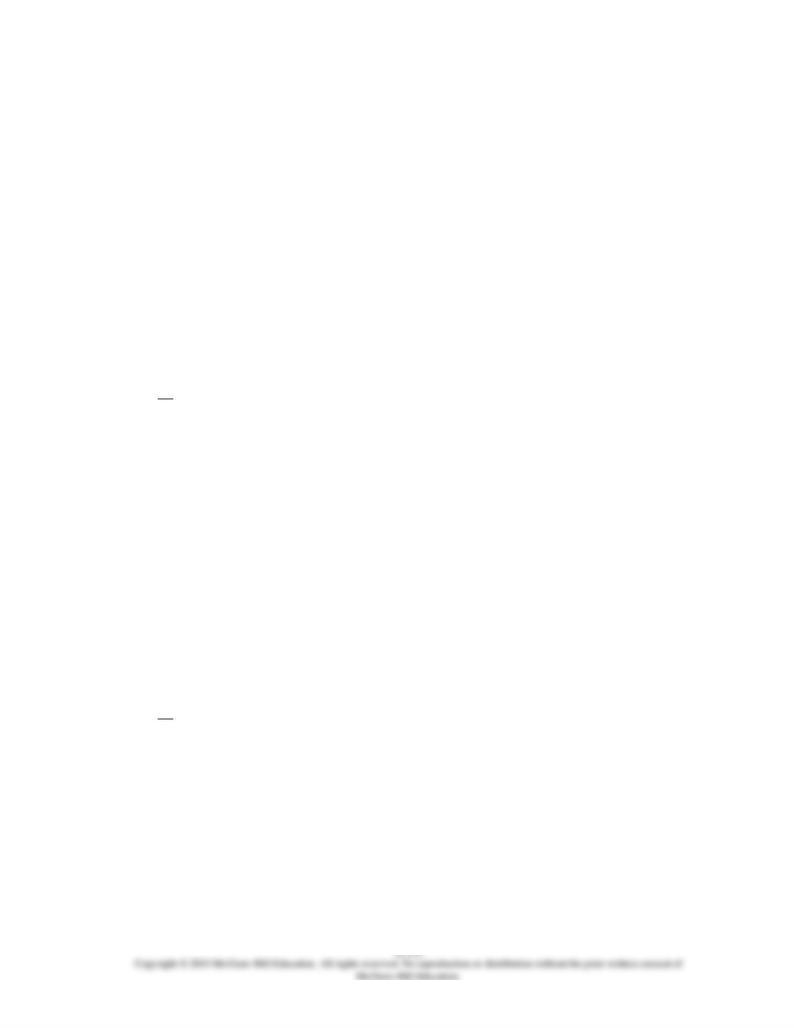
Accessibility: Keyboard Navigation
Blooms: Apply
Difficulty: 2 Medium
Learning Objective: 12-03 Explain how demand is seen by a pure monopoly.
Topic: Monopoly Demand
45.
A monopolist sells 6 units of a product per day at a unit price of $15. If it
lowers price to $14, its total revenue increases by $22. This implies that its
sales quantity increases by:
A.
4 units per day
B.
3 units per day
C.
2 units per day
D.
1 unit per day
AACSB: Analytic
Accessibility: Keyboard Navigation
Blooms: Apply
Difficulty: 2 Medium
Learning Objective: 12-03 Explain how demand is seen by a pure monopoly.
Topic: Monopoly Demand
46.
For a monopolist to sell an output level of 10 units, the price must be $8.
MR at this output level will be:
A.
> $8 and < $16
B.
< $8
C.
= $8
D.
> $16
AACSB: Analytic
Accessibility: Keyboard Navigation
Blooms: Apply
Difficulty: 3 Hard
Learning Objective: 12-03 Explain how demand is seen by a pure monopoly.
Topic: Monopoly Demand
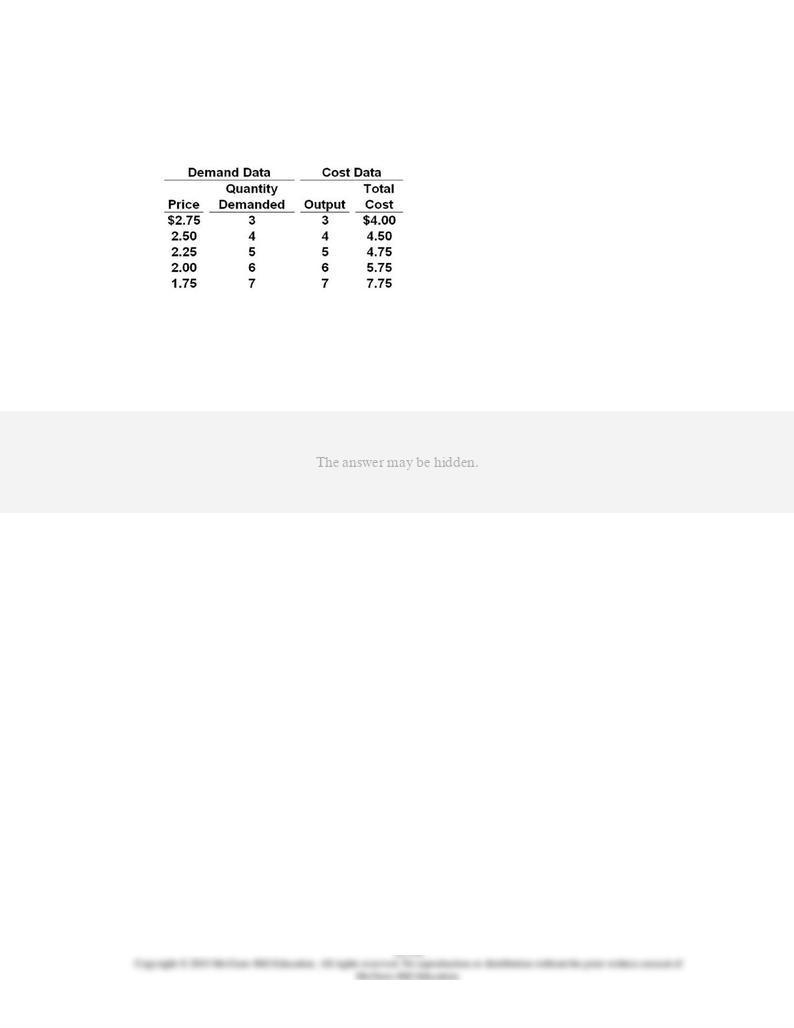
47.
Answer the question below on the basis of the following demand and cost
data for a pure monopolist.
Refer to the above table. The profit-maximizing price for the monopolist will
be:
AACSB: Analytic
Blooms: Analyze
Difficulty: 3 Hard
Learning Objective: 12-04 Explain how a pure monopoly sets its profit-maximizing output and price.
Topic: Output and Price Determination

48.
Answer the question below on the basis of the following demand and cost
data for a pure monopolist.
Refer to the above table. At equilibrium, the monopolist will realize a:
AACSB: Analytic
Blooms: Analyze
Difficulty: 3 Hard
Learning Objective: 12-04 Explain how a pure monopoly sets its profit-maximizing output and price.
Topic: Output and Price Determination
49.
At the profit-maximizing level of output for a monopolist:
AACSB: Analytic
Accessibility: Keyboard Navigation
Blooms: Remember
Difficulty: 3 Hard
Learning Objective: 12-04 Explain how a pure monopoly sets its profit-maximizing output and price.
Topic: Output and Price Determination
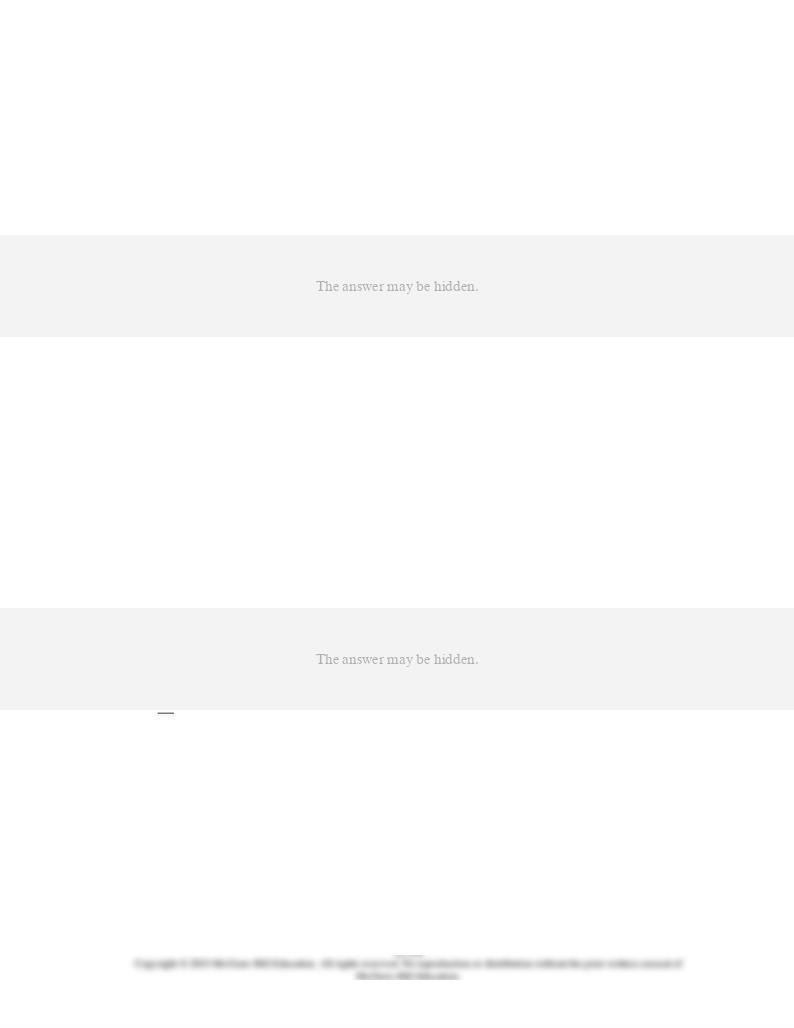
50.
Suppose that a monopolist calculates that at present its output level,
marginal revenue is $1.00 and marginal cost is $2.00. He or she could
maximize profits or minimize losses by:
AACSB: Analytic
Accessibility: Keyboard Navigation
Blooms: Understand
Difficulty: 2 Medium
Learning Objective: 12-04 Explain how a pure monopoly sets its profit-maximizing output and price.
Topic: Output and Price Determination
51.
Many people believe that monopolies charge any price they want to without
affecting sales. Instead, the output level for a profit-maximizing monopoly
is determined by:
AACSB: Analytic
Accessibility: Keyboard Navigation
Blooms: Remember
Difficulty: 1 Easy
Learning Objective: 12-04 Explain how a pure monopoly sets its profit-maximizing output and price.
Topic: Output and Price Determination
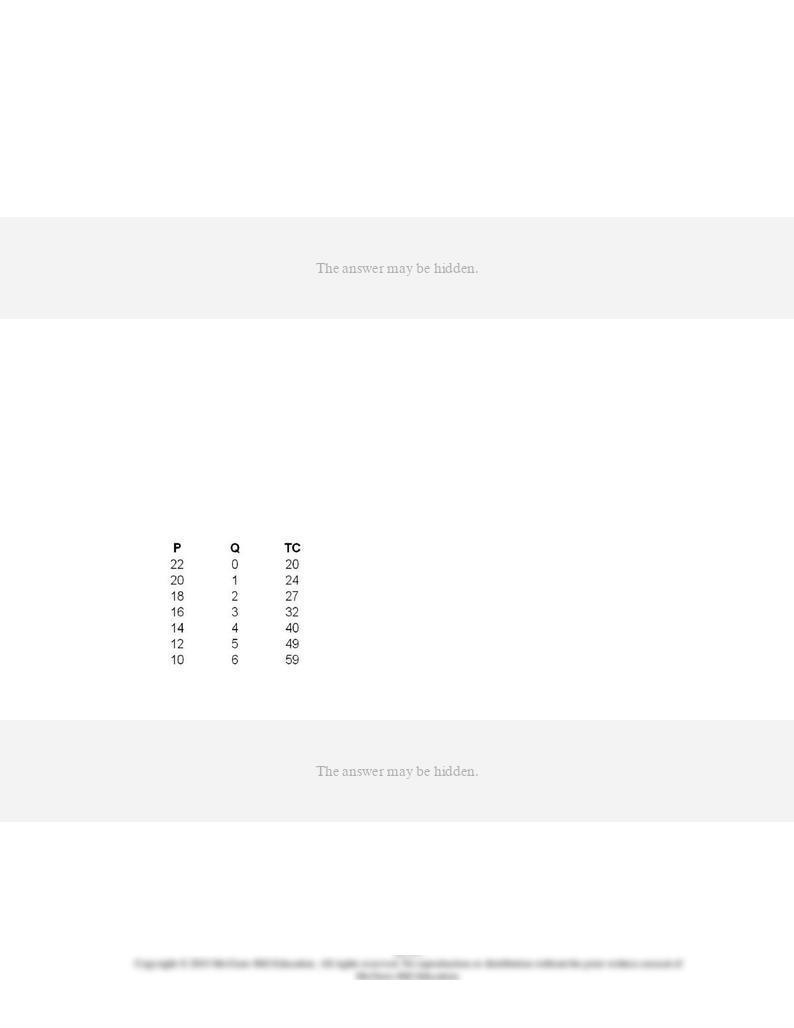
52.
Suppose that a monopolist calculates that at its present output level,
marginal cost is $4.00 and marginal revenue is $5.00. The firm could
increase profits by:
AACSB: Analytic
Accessibility: Keyboard Navigation
Blooms: Apply
Difficulty: 2 Medium
Learning Objective: 12-04 Explain how a pure monopoly sets its profit-maximizing output and price.
Topic: Output and Price Determination
53.
The data below relate to a pure monopolist and the product it produces.
What is the profit-maximizing output and price for this monopolist?
AACSB: Analytic
Blooms: Apply
Difficulty: 2 Medium
Learning Objective: 12-04 Explain how a pure monopoly sets its profit-maximizing output and price.
Topic: Output and Price Determination
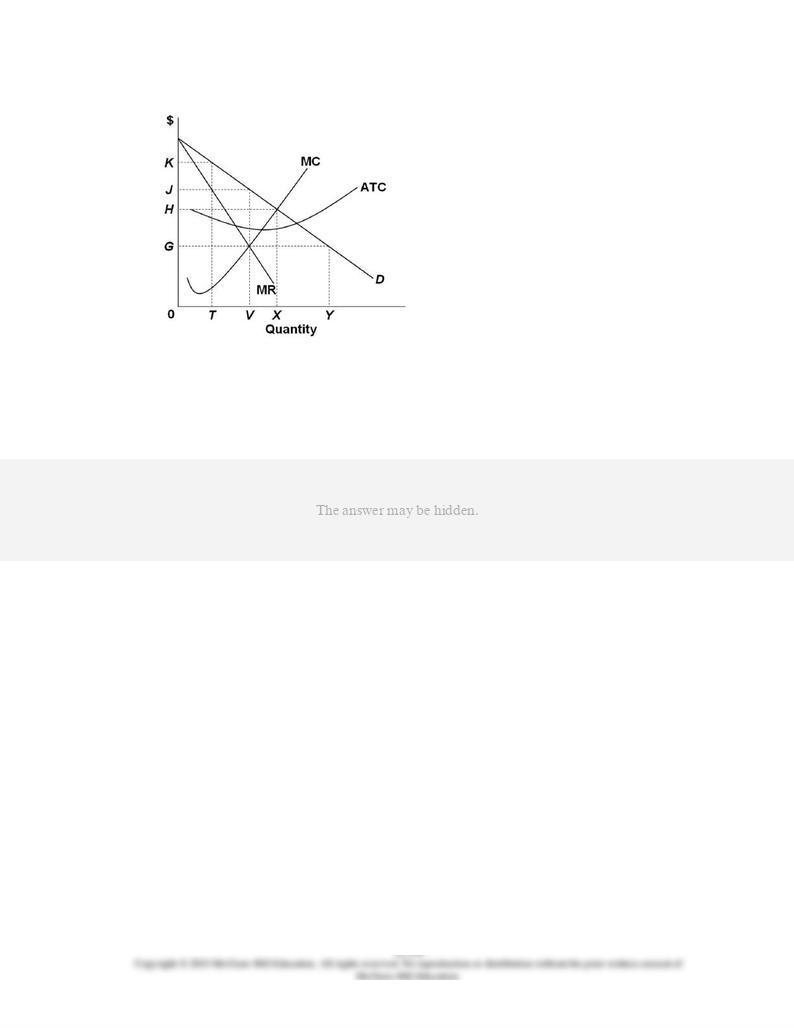
54.
Refer to the above graph for a profit-maximizing monopolist. The firm will
set its price at:
AACSB: Analytic
Blooms: Apply
Difficulty: 2 Medium
Learning Objective: 12-04 Explain how a pure monopoly sets its profit-maximizing output and price.
Topic: Output and Price Determination
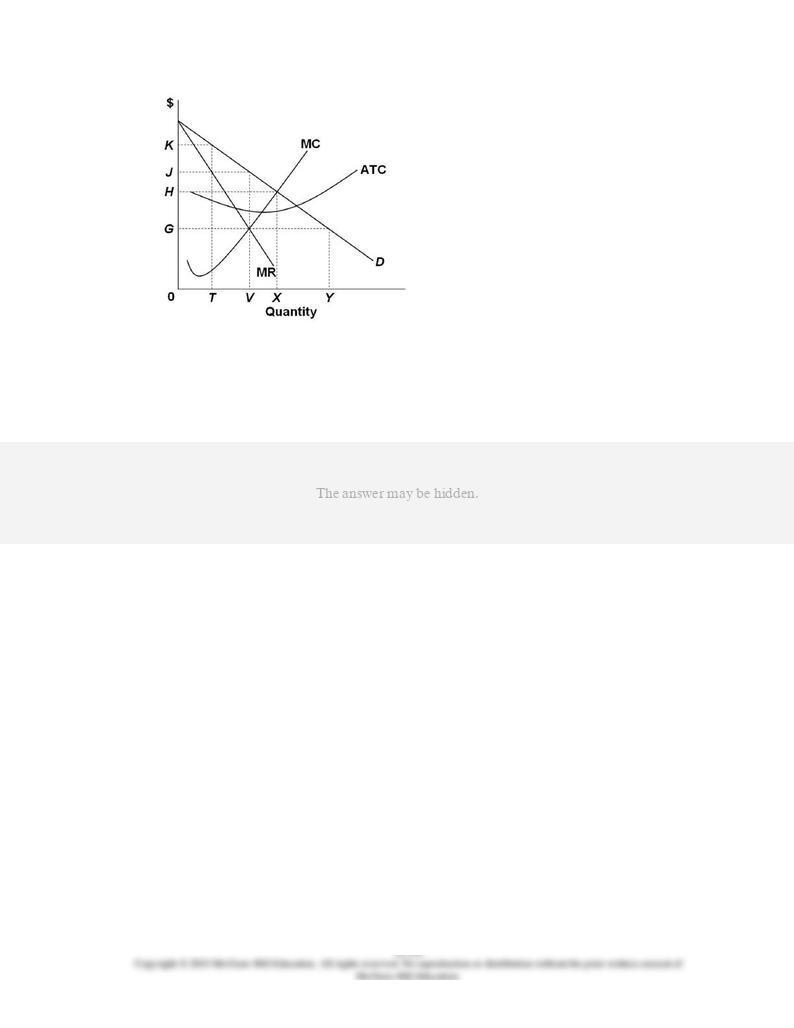
55.
Refer to the above graph for a profit-maximizing monopolist. The firm will
produce the quantity:
AACSB: Analytic
Blooms: Apply
Difficulty: 1 Easy
Learning Objective: 12-04 Explain how a pure monopoly sets its profit-maximizing output and price.
Topic: Output and Price Determination
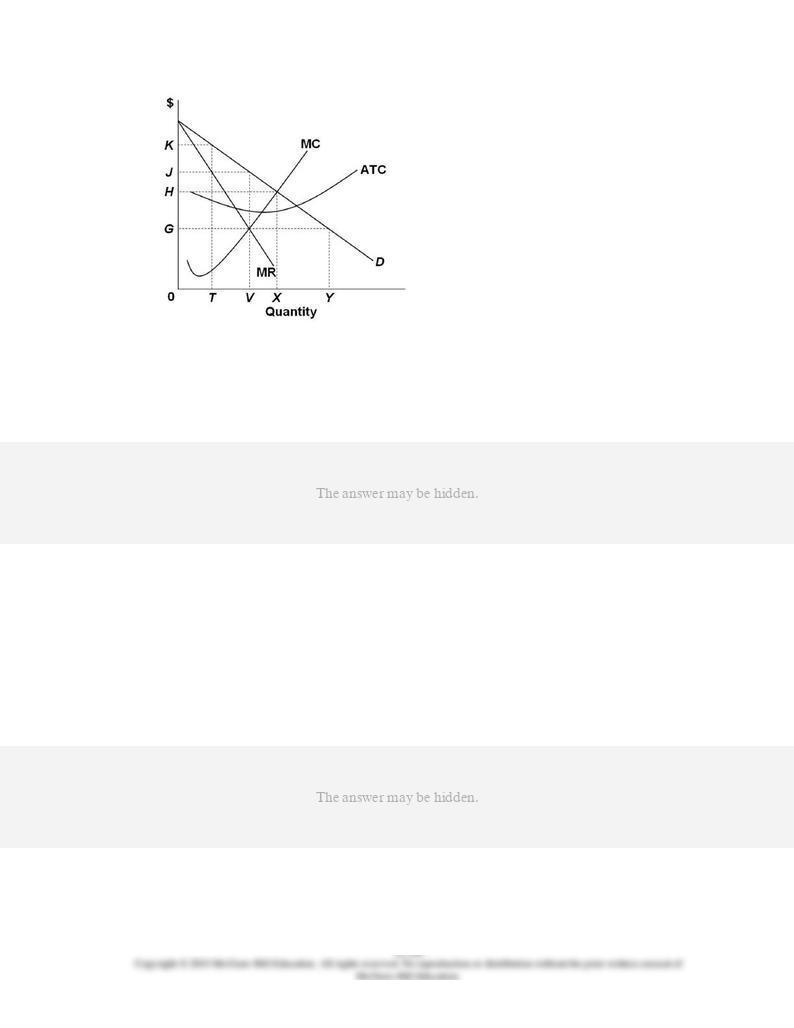
56.
Refer to the above graph for a profit-maximizing monopolist. At equilibrium,
the firm will be earning:
AACSB: Analytic
Blooms: Apply
Difficulty: 2 Medium
Learning Objective: 12-04 Explain how a pure monopoly sets its profit-maximizing output and price.
Topic: Output and Price Determination
57.
Pure monopolists:
AACSB: Analytic
Accessibility: Keyboard Navigation
Blooms: Remember
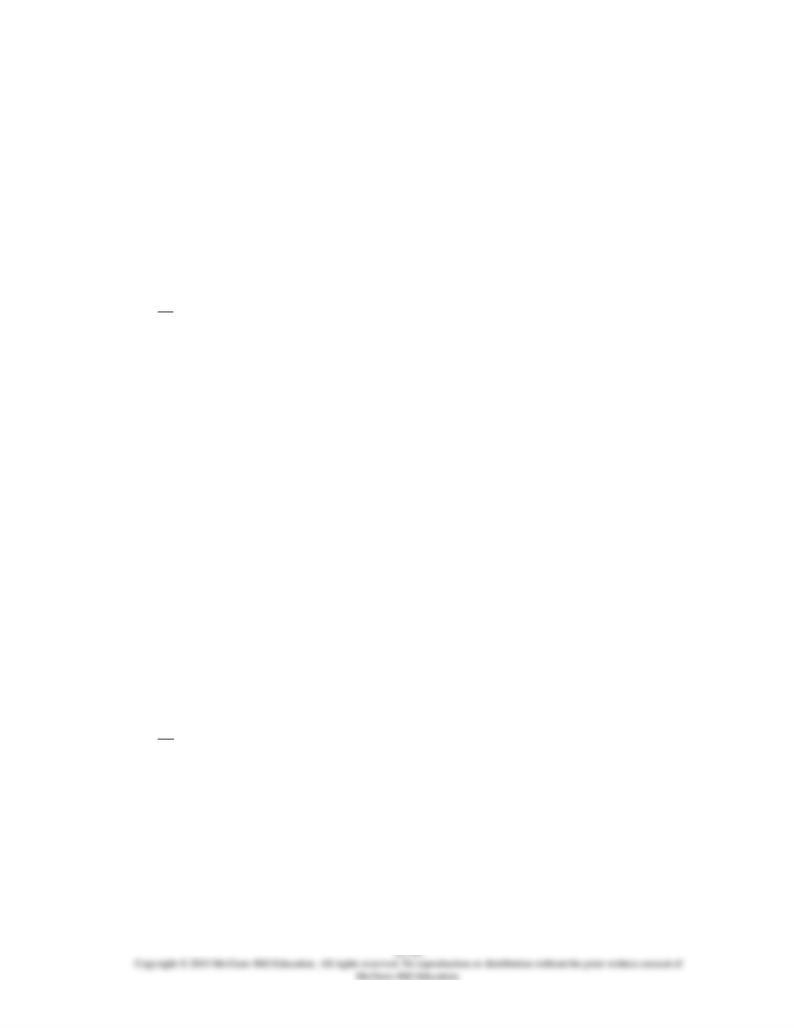
Difficulty: 2 Medium
Learning Objective: 12-04 Explain how a pure monopoly sets its profit-maximizing output and price.
Topic: Output and Price Determination
58.
A firm will earn economic profits whenever:
A.
Marginal revenue exceeds marginal costs
B.
Marginal revenue exceeds variable costs
C.
Average revenue exceeds average total costs
D.
Average revenue exceeds average variable costs
AACSB: Analytic
Accessibility: Keyboard Navigation
Blooms: Remember
Difficulty: 1 Easy
Learning Objective: 12-04 Explain how a pure monopoly sets its profit-maximizing output and price.
Topic: Output and Price Determination
59.
The supply curve for a monopoly is:
A.
The portion of the marginal cost curve that lies above the average
variable cost curve
B.
The portion of the marginal cost curve that lies above the average total
cost curve
C.
The portion of the marginal cost curve that lies above the average fixed
cost curve
D.
Not clearly defined
AACSB: Analytic
Accessibility: Keyboard Navigation
Blooms: Understand
Difficulty: 2 Medium
Learning Objective: 12-04 Explain how a pure monopoly sets its profit-maximizing output and price.
Topic: Output and Price Determination
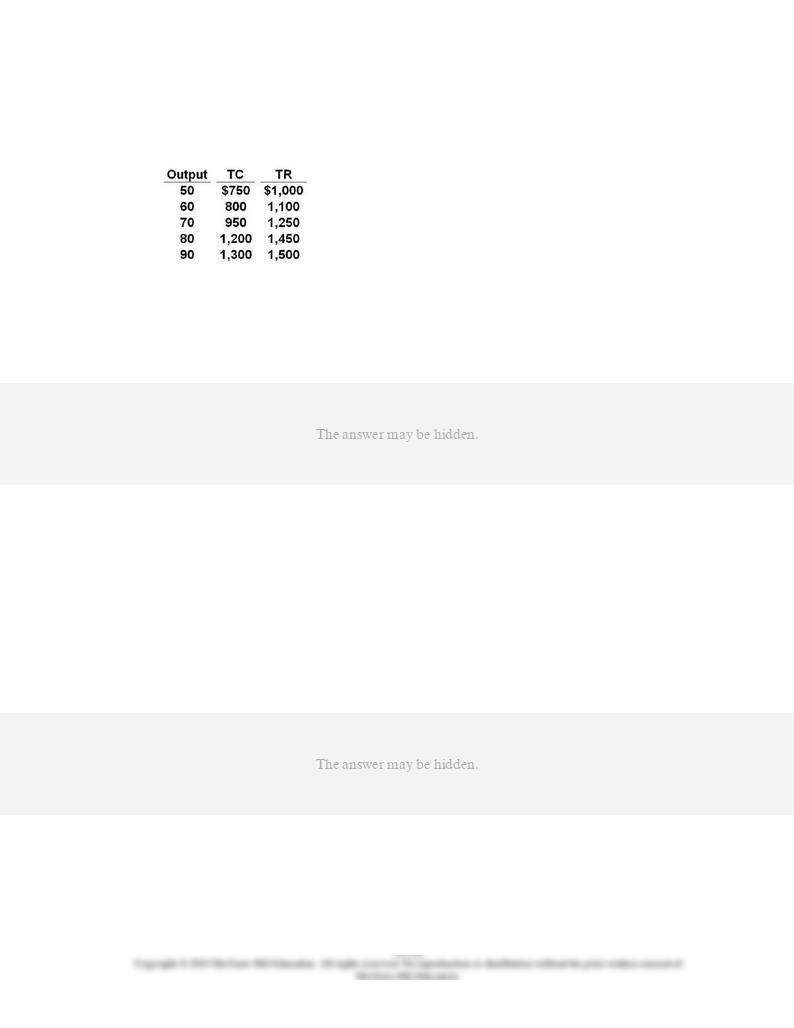
60.
The following data show the relationship between output, total costs, and
total revenue for a pure monopoly.
Within which of the following ranges of output will the firm earn maximum
economic profits?
AACSB: Analytic
Blooms: Apply
Difficulty: 2 Medium
Learning Objective: 12-04 Explain how a pure monopoly sets its profit-maximizing output and price.
Topic: Output and Price Determination
61.
A profit-maximizing firm should shut down in the short run if the average
revenue it receives is less than:
AACSB: Analytic
Accessibility: Keyboard Navigation
Blooms: Remember
Difficulty: 1 Easy
Learning Objective: 12-04 Explain how a pure monopoly sets its profit-maximizing output and price.

Topic: Output and Price Determination
62.
A profit-maximizing monopolist facing the situation shown in the graph
above should:
AACSB: Analytic
Blooms: Apply
Difficulty: 1 Easy
Learning Objective: 12-04 Explain how a pure monopoly sets its profit-maximizing output and price.
Topic: Output and Price Determination

63.
At equilibrium, the profit-maximizing monopolist facing the situation shown
in the graph will face a negative:
AACSB: Analytic
Blooms: Apply
Difficulty: 2 Medium
Learning Objective: 12-04 Explain how a pure monopoly sets its profit-maximizing output and price.
Topic: Output and Price Determination
64.
In the short run equilibrium, a monopolist's profits:
AACSB: Analytic
Accessibility: Keyboard Navigation
Blooms: Remember
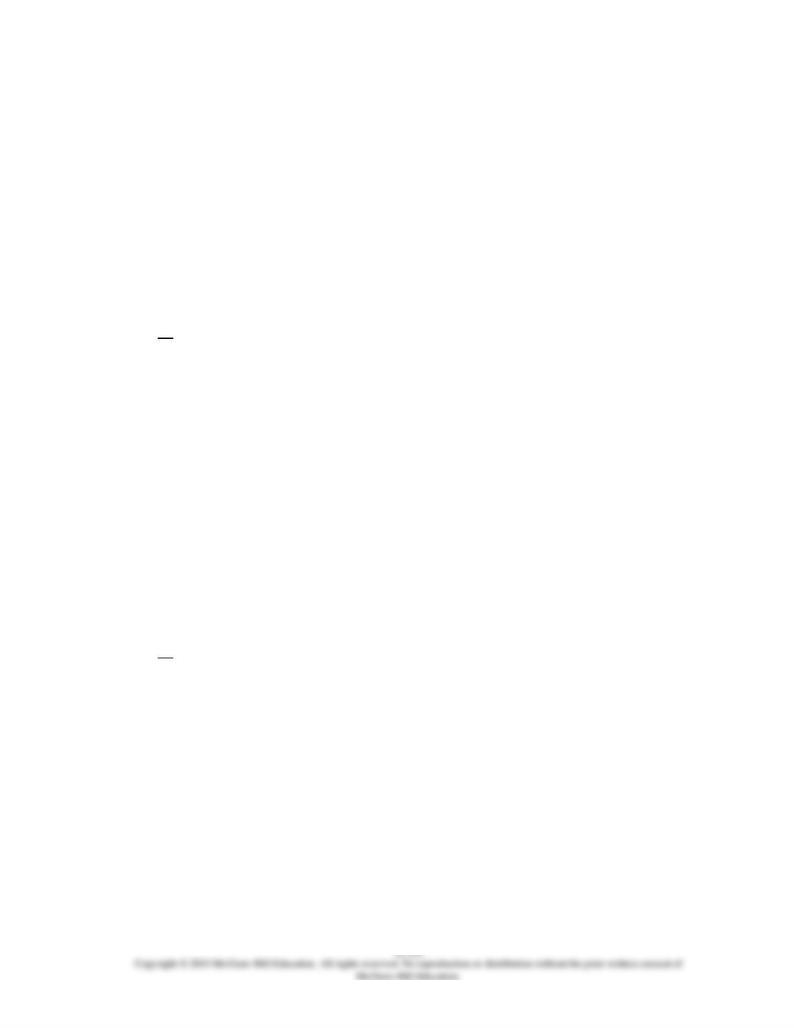
Difficulty: 1 Easy
Learning Objective: 12-04 Explain how a pure monopoly sets its profit-maximizing output and price.
Topic: Output and Price Determination
65.
In response to a cost-reducing technological breakthrough in the
production of its product, a profit-maximizing monopolist will normally:
A.
Increase price and decrease production
B.
Not change its level of output or price
C.
Decrease the price it charges for its product
D.
Increase its output and practice price discrimination
AACSB: Reflective Thinking
Accessibility: Keyboard Navigation
Blooms: Apply
Difficulty: 3 Hard
Learning Objective: 12-04 Explain how a pure monopoly sets its profit-maximizing output and price.
Topic: Output and Price Determination
66.
If marginal costs decrease and the MC curve shifts down, a typical
monopolist will:
A.
Reduce price and reduce quantity of output
B.
Reduce price and increase quantity of output
C.
Increase price and reduce quantity of output
D.
Increase price and increase quantity of output
AACSB: Reflective Thinking
Accessibility: Keyboard Navigation
Blooms: Apply
Difficulty: 2 Medium
Learning Objective: 12-04 Explain how a pure monopoly sets its profit-maximizing output and price.
Topic: Output and Price Determination

67.
Refer to the above graph for a monopolist in short-run equilibrium. This
monopolist will charge a price:
AACSB: Analytic
Blooms: Apply
Difficulty: 3 Hard
Learning Objective: 12-04 Explain how a pure monopoly sets its profit-maximizing output and price.
Topic: Output and Price Determination
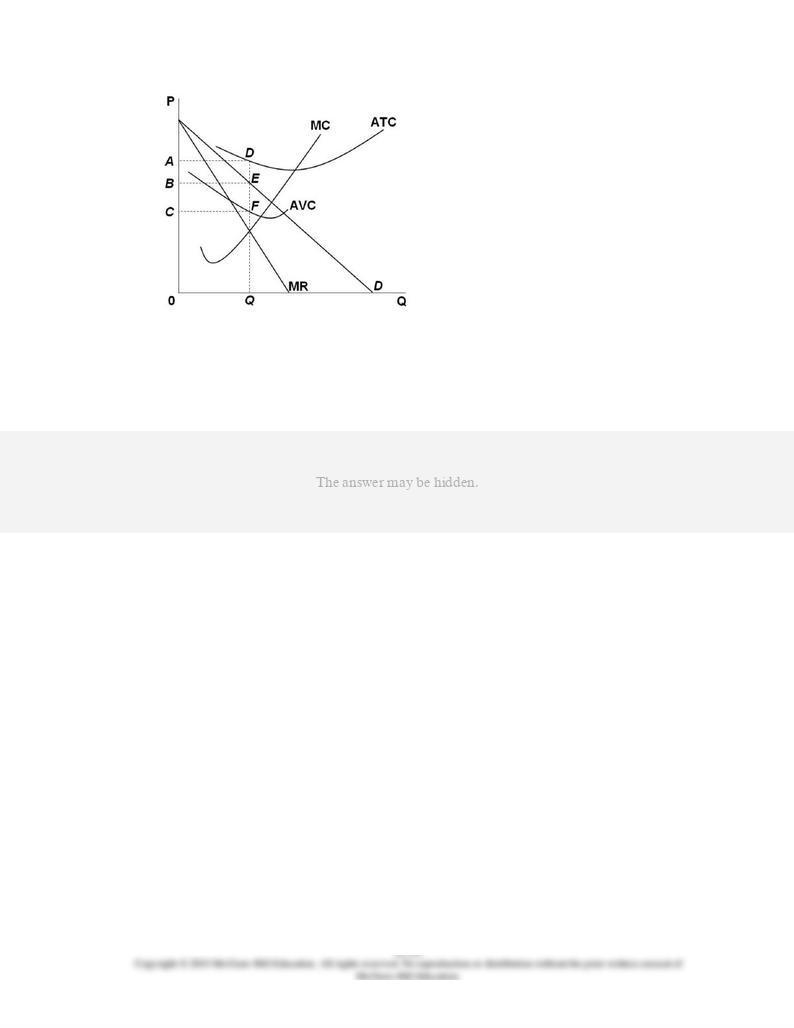
68.
Refer to the above graph for a monopolist in short-run equilibrium. This
monopolist:
AACSB: Analytic
Blooms: Analyze
Difficulty: 3 Hard
Learning Objective: 12-04 Explain how a pure monopoly sets its profit-maximizing output and price.
Topic: Output and Price Determination
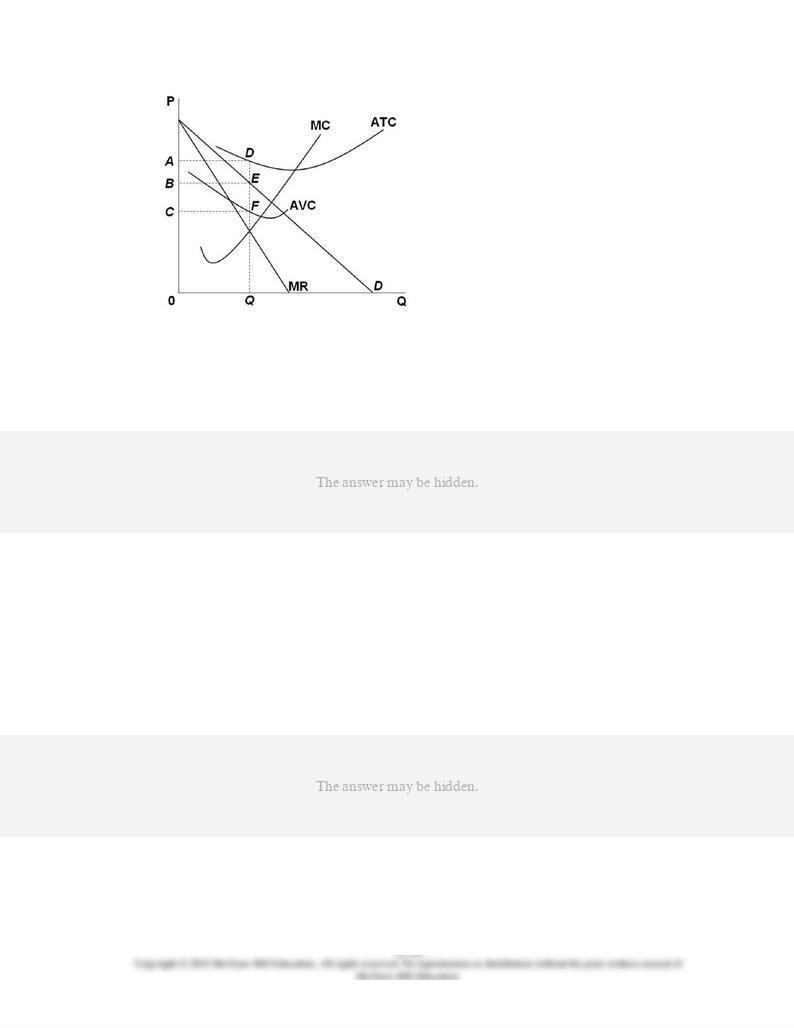
69.
Refer to the above graph for a monopolist in short-run equilibrium. This
monopolist has total cost equal to area:
AACSB: Analytic
Blooms: Analyze
Difficulty: 3 Hard
Learning Objective: 12-04 Explain how a pure monopoly sets its profit-maximizing output and price.
Topic: Output and Price Determination
70.
Which of the following does
not
necessarily apply to a pure monopoly?
AACSB: Analytic
Accessibility: Keyboard Navigation
Blooms: Remember
Difficulty: 1 Easy

Learning Objective: 12-04 Explain how a pure monopoly sets its profit-maximizing output and price.
Topic: Output and Price Determination
71.
Which statement is correct?
AACSB: Analytic
Accessibility: Keyboard Navigation
Blooms: Understand
Difficulty: 2 Medium
Learning Objective: 12-04 Explain how a pure monopoly sets its profit-maximizing output and price.
Topic: Output and Price Determination
72.
Under which of the following conditions would a profit-maximizing
monopolist necessarily raise price?
AACSB: Analytic
Accessibility: Keyboard Navigation
Blooms: Apply
Difficulty: 3 Hard
Learning Objective: 12-04 Explain how a pure monopoly sets its profit-maximizing output and price.
Topic: Output and Price Determination
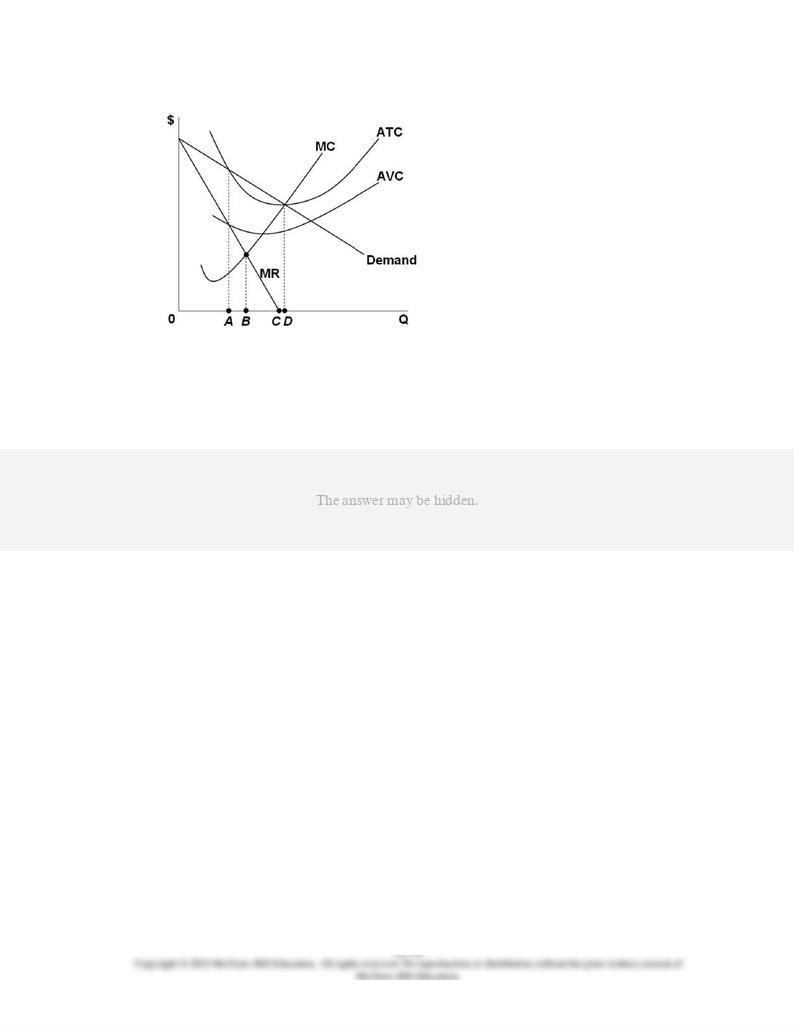
73.
Refer to the graph above. What is the profit-maximizing level of output for
this pure monopolist?
AACSB: Analytic
Blooms: Apply
Difficulty: 2 Medium
Learning Objective: 12-04 Explain how a pure monopoly sets its profit-maximizing output and price.
Topic: Output and Price Determination
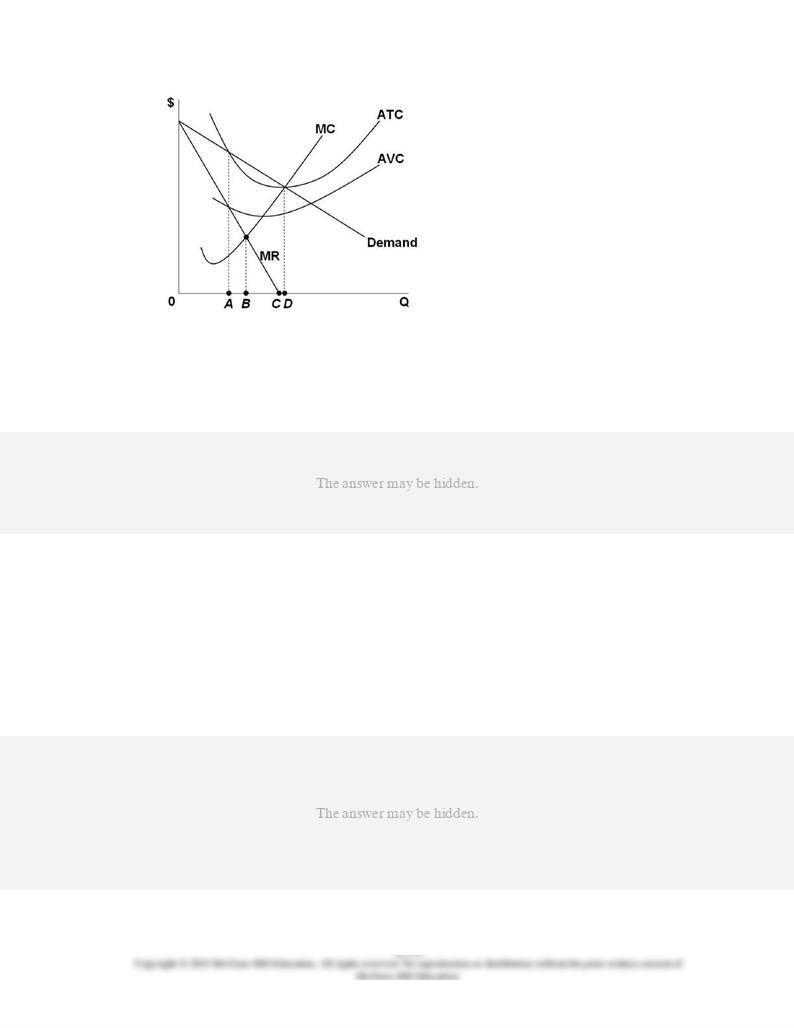
74.
Refer to the graph above. At its equilibrium level of output, this monopolist
earns:
AACSB: Analytic
Blooms: Apply
Difficulty: 2 Medium
Learning Objective: 12-04 Explain how a pure monopoly sets its profit-maximizing output and price.
Topic: Output and Price Determination
75.
Monopolists are said to be allocatively
inefficient
because:
AACSB: Analytic
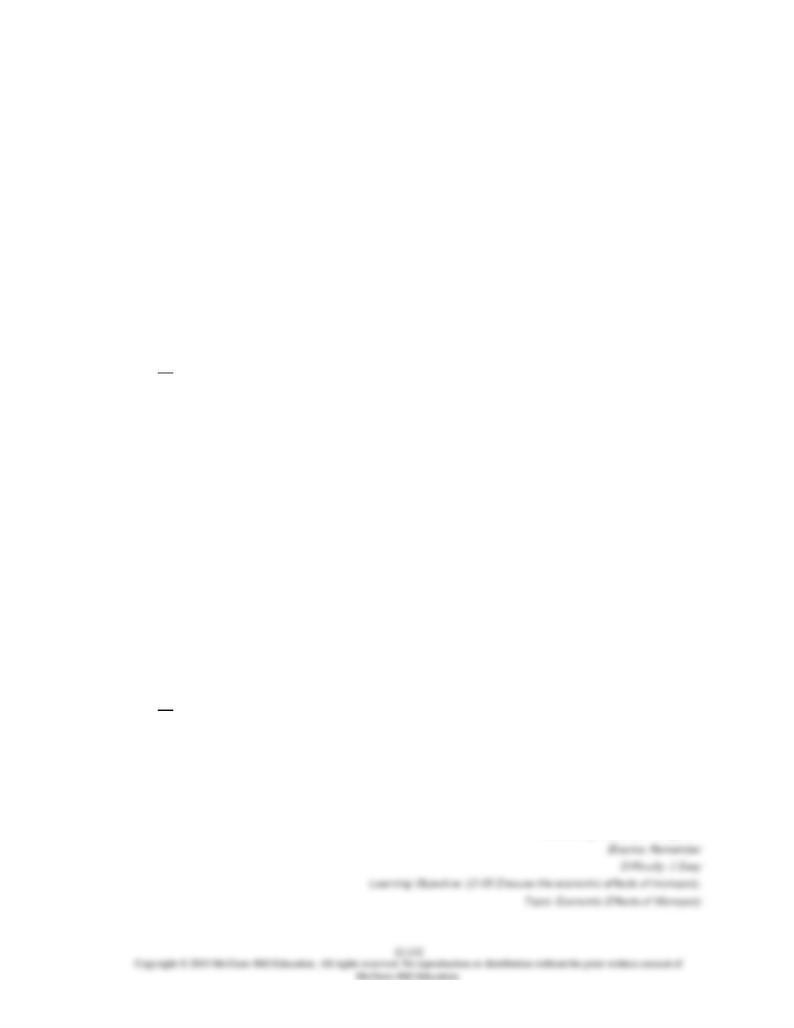
Accessibility: Keyboard Navigation
Blooms: Understand
Difficulty: 2 Medium
Learning Objective: 12-05 Discuss the economic effects of monopoly.
Topic: Economic Effects of Monopoly
76.
Allocative inefficiency happens in a monopoly because at the profit-
maximizing output level:
A.
P
> ATC
B.
P
> MR
C.
P
> MC
D.
P
> AVC
AACSB: Analytic
AACSB: Communication
Accessibility: Keyboard Navigation
Blooms: Remember
Difficulty: 1 Easy
Learning Objective: 12-05 Discuss the economic effects of monopoly.
Topic: Economic Effects of Monopoly
77.
A monopoly results in productive inefficiency because at the profit-
maximizing output level:
A.
MR is not zero
B.
ATC is not at its minimum level
C.
MC is not at its minimum level
D.
P
> AVC
AACSB: Analytic
AACSB: Communication
Accessibility: Keyboard Navigation

78.
When compared with the purely competitive industry with identical costs of
production, a monopolist will produce:
AACSB: Analytic
Accessibility: Keyboard Navigation
Blooms: Remember
Difficulty: 2 Medium
Learning Objective: 12-05 Discuss the economic effects of monopoly.
Topic: Economic Effects of Monopoly
79.
Which is a major criticism of a monopoly as a source of allocative
inefficiency?
AACSB: Analytic
Accessibility: Keyboard Navigation
Blooms: Understand
Difficulty: 2 Medium
Learning Objective: 12-05 Discuss the economic effects of monopoly.
Topic: Economic Effects of Monopoly

80.
A non-discriminating pure monopolist is generally viewed as:
AACSB: Analytic
Accessibility: Keyboard Navigation
Blooms: Remember
Difficulty: 1 Easy
Learning Objective: 12-05 Discuss the economic effects of monopoly.
Topic: Economic Effects of Monopoly

81.
Refer to the graph above. If the industry were purely competitive, then the
market price would be:
AACSB: Analytic
Blooms: Apply
Difficulty: 2 Medium
Learning Objective: 12-05 Discuss the economic effects of monopoly.
Topic: Economic Effects of Monopoly
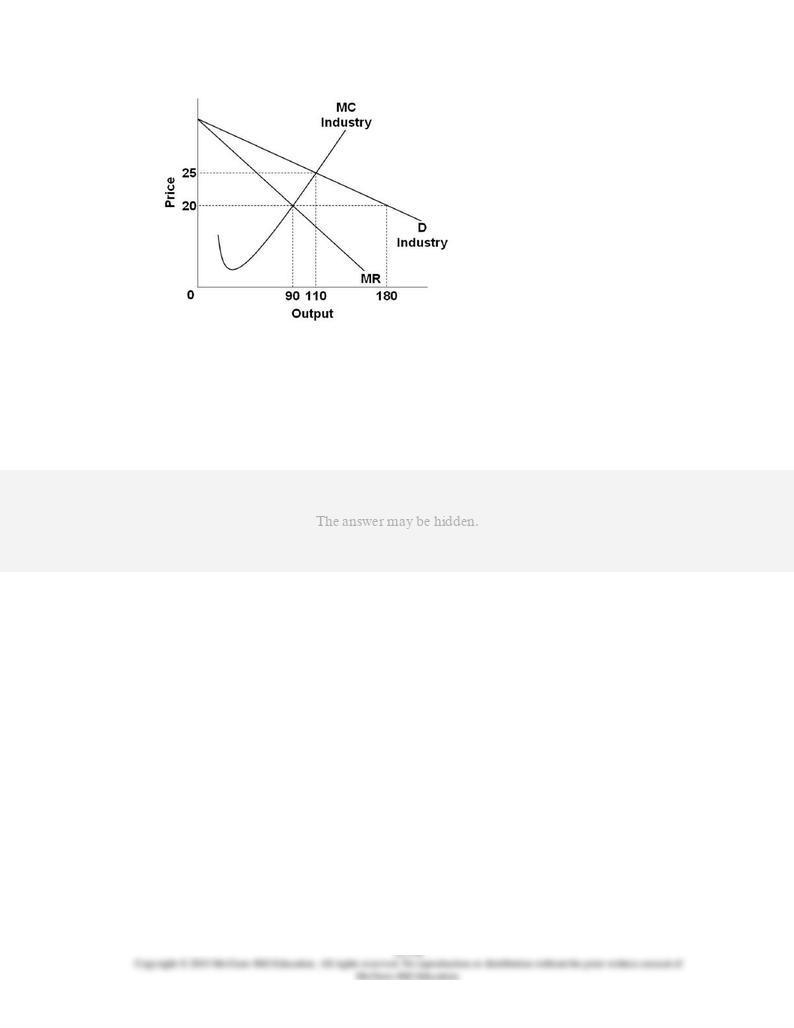
82.
Based on the graph above, what is the difference between the purely
competitive equilibrium level of output and the pure monopoly equilibrium
level of output?
AACSB: Analytic
Blooms: Apply
Difficulty: 3 Hard
Learning Objective: 12-05 Discuss the economic effects of monopoly.
Topic: Economic Effects of Monopoly

83.
Compared to the purely competitive industry, a pure monopoly:
AACSB: Analytic
Accessibility: Keyboard Navigation
Blooms: Remember
Difficulty: 1 Easy
Learning Objective: 12-05 Discuss the economic effects of monopoly.
Topic: Economic Effects of Monopoly
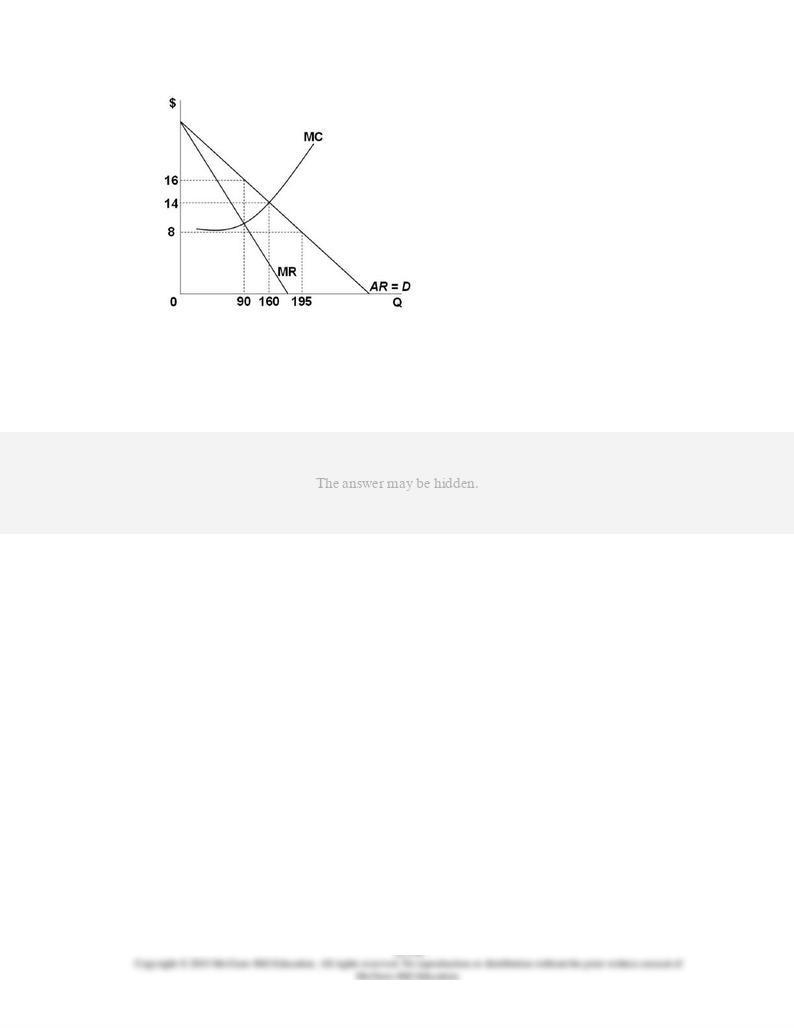
84.
Refer to the graph above for an industry. If the industry were purely
competitive, the output quantity would be:
AACSB: Analytic
Blooms: Apply
Difficulty: 3 Hard
Learning Objective: 12-05 Discuss the economic effects of monopoly.
Topic: Economic Effects of Monopoly
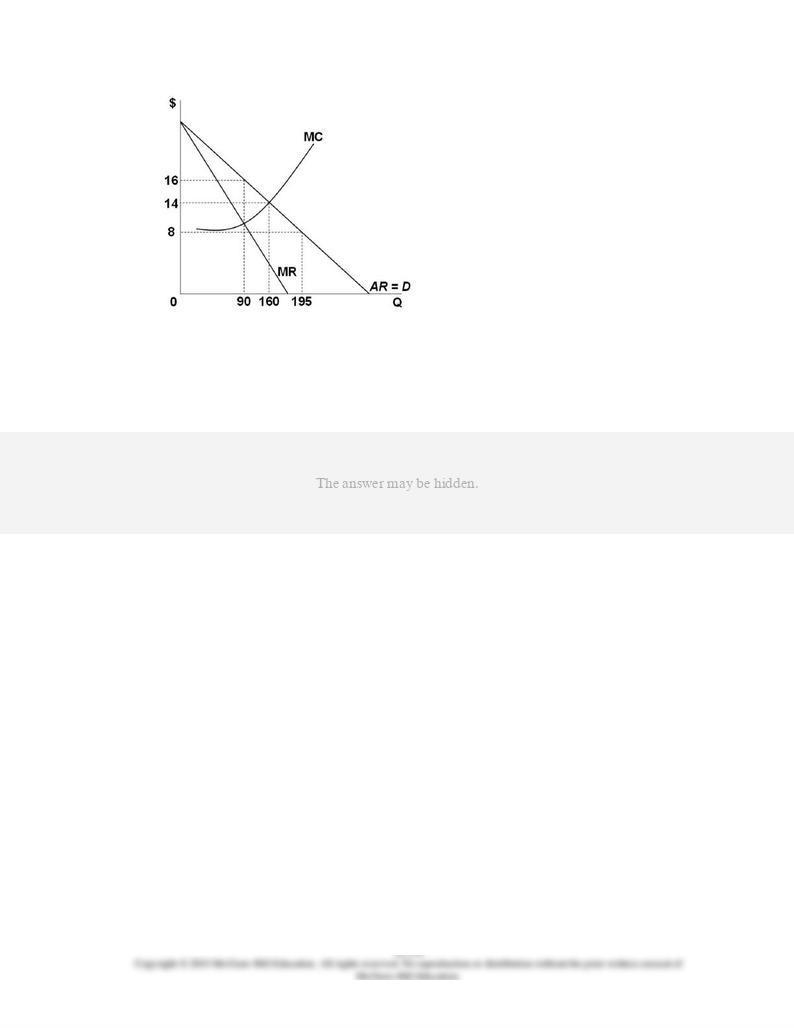
85.
Refer to the graph above for an industry. If the industry operates as a pure
monopoly, the output quantity would be:
AACSB: Analytic
Blooms: Apply
Difficulty: 3 Hard
Learning Objective: 12-05 Discuss the economic effects of monopoly.
Topic: Economic Effects of Monopoly

86.
Refer to the graph above for an industry. If the industry were purely
competitive, the market price would be:
AACSB: Analytic
Blooms: Apply
Difficulty: 3 Hard
Learning Objective: 12-05 Discuss the economic effects of monopoly.
Topic: Economic Effects of Monopoly
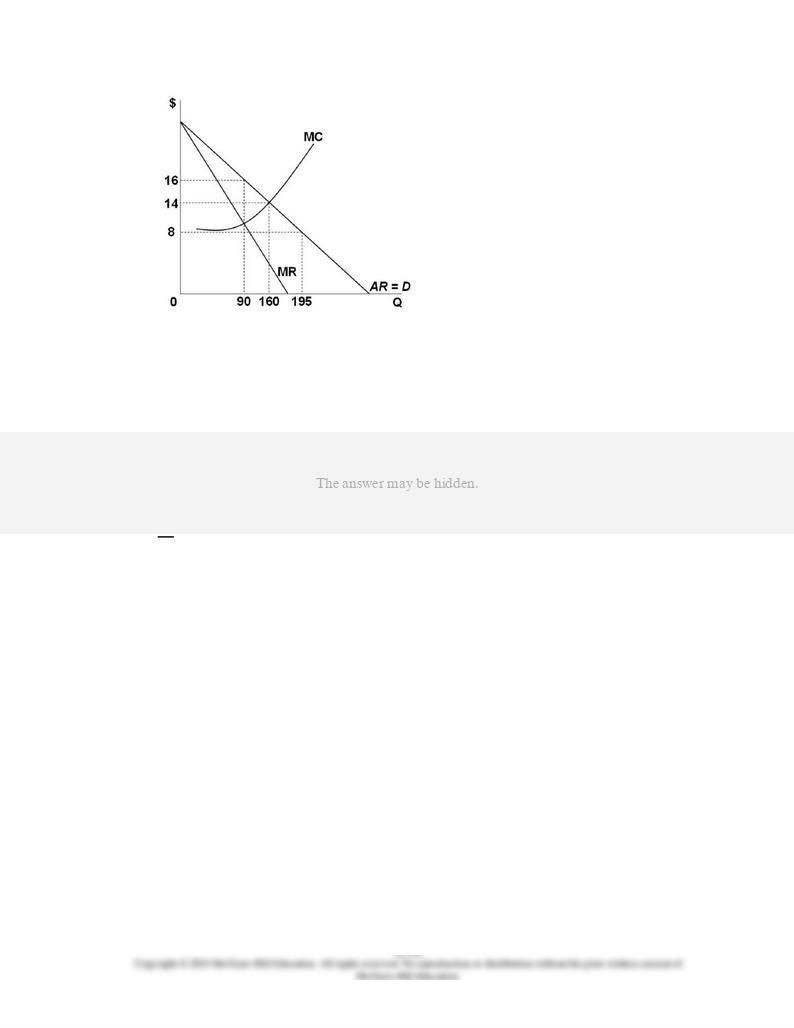
87.
Refer to the graph above for an industry. If the industry were a pure
monopoly, the product price would be:
AACSB: Analytic
Blooms: Apply
Difficulty: 3 Hard
Learning Objective: 12-05 Discuss the economic effects of monopoly.
Topic: Economic Effects of Monopoly
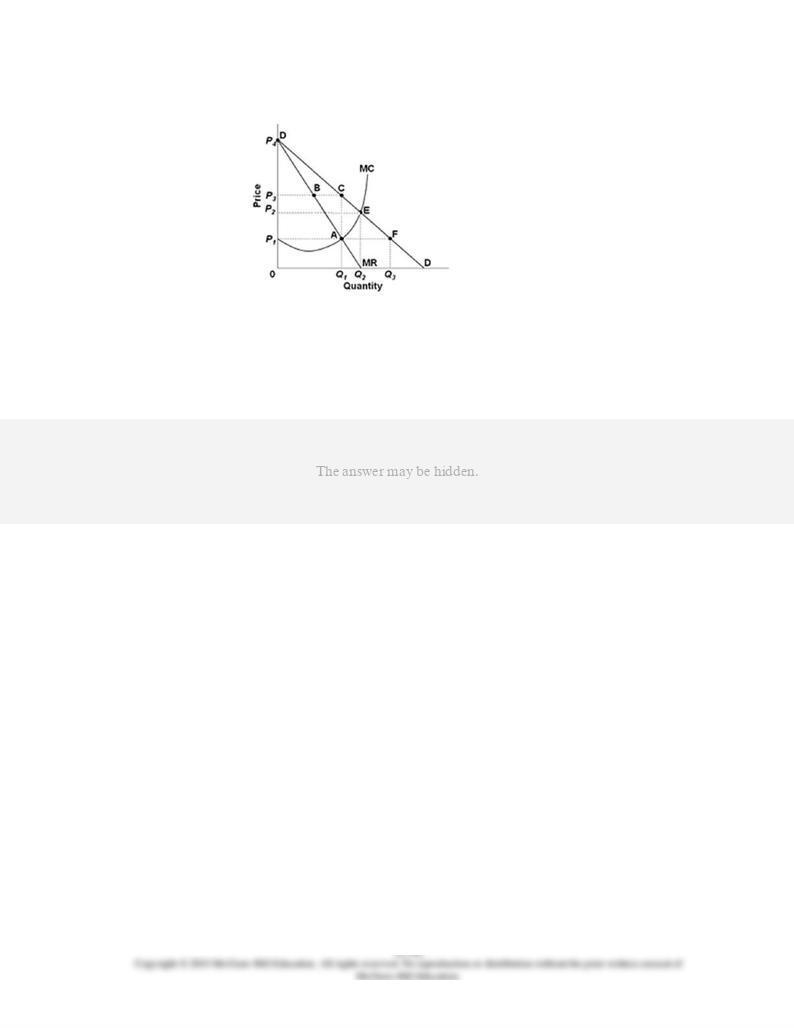
88.
Refer to the above graph for an industry. If the industry were served by a
pure monopoly, the price and output quantity would be:
AACSB: Analytic
Blooms: Apply
Difficulty: 2 Medium
Learning Objective: 12-05 Discuss the economic effects of monopoly.
Topic: Economic Effects of Monopoly
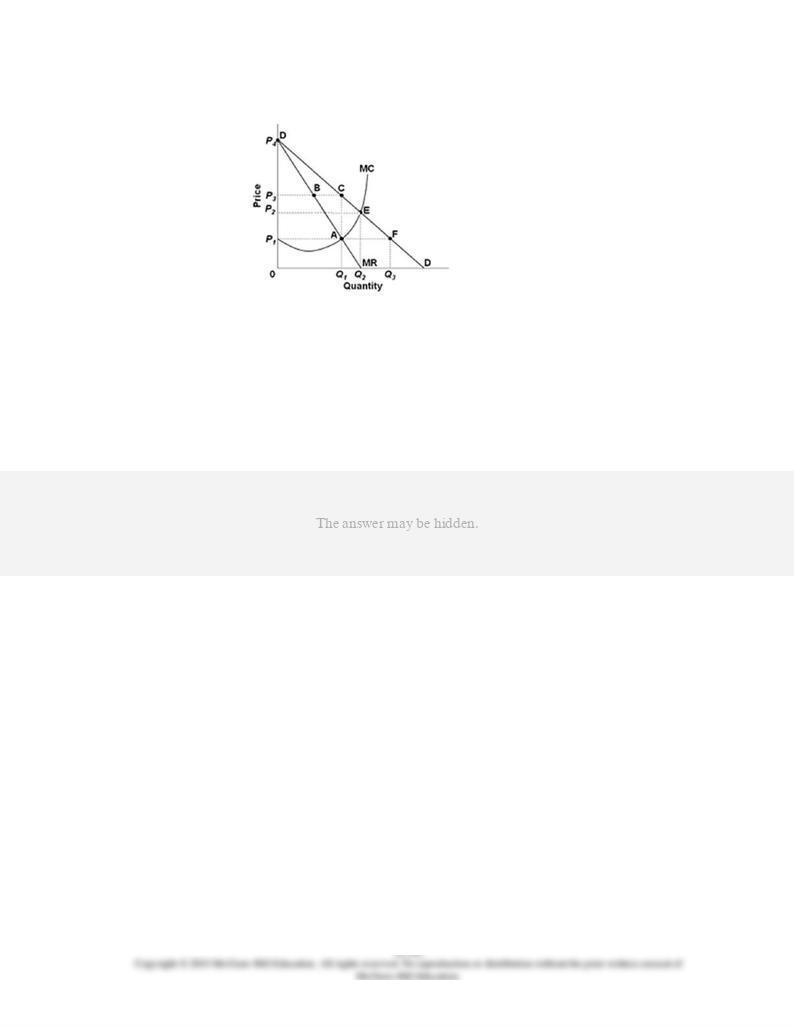
89.
Refer to the above graph for an industry. If the industry was initially a
monopoly, but the monopolist was broken up into a large number of small,
purely competitive firms and production costs remained unchanged, then
market price and industry output would be:
AACSB: Analytic
Blooms: Apply
Difficulty: 2 Medium
Learning Objective: 12-05 Discuss the economic effects of monopoly.
Topic: Economic Effects of Monopoly

90.
Marginal costs of a producer may be very small due to its product's ability
to satisfy a large number of consumers at the same time. This
characteristic of a product is called:
AACSB: Analytic
AACSB: Communication
Accessibility: Keyboard Navigation
Blooms: Remember
Difficulty: 1 Easy
Learning Objective: 12-05 Discuss the economic effects of monopoly.
Topic: Economic Effects of Monopoly
91.
With non-rivalrous consumption such as in the case of online music and
movies, as more consumers buy the product:
AACSB: Analytic
Accessibility: Keyboard Navigation
Blooms: Remember
Difficulty: 1 Easy
Learning Objective: 12-05 Discuss the economic effects of monopoly.
Topic: Economic Effects of Monopoly

92.
When the value of a product to each user, including existing users,
increases due to an increase in the total number of users, we refer to this
as:
AACSB: Analytic
AACSB: Communication
Accessibility: Keyboard Navigation
Blooms: Remember
Difficulty: 1 Easy
Learning Objective: 12-05 Discuss the economic effects of monopoly.
Topic: Economic Effects of Monopoly
93.
Network effects and simultaneous consumption tend to foster the
development of:
AACSB: Reflective Thinking
Accessibility: Keyboard Navigation
Blooms: Apply
Difficulty: 2 Medium
Learning Objective: 12-05 Discuss the economic effects of monopoly.
Topic: Economic Effects of Monopoly

94.
X-inefficiency is said to occur when a monopolist's:
AACSB: Analytic
AACSB: Communication
Accessibility: Keyboard Navigation
Blooms: Remember
Difficulty: 1 Easy
Learning Objective: 12-05 Discuss the economic effects of monopoly.
Topic: Economic Effects of Monopoly
95.
Possible reasons for X-inefficiency include the following,
except
:
AACSB: Analytic
Accessibility: Keyboard Navigation
Blooms: Understand
Difficulty: 2 Medium
Learning Objective: 12-05 Discuss the economic effects of monopoly.
Topic: Economic Effects of Monopoly

96.
Which of the following statements is correct?
AACSB: Analytic
Accessibility: Keyboard Navigation
Blooms: Understand
Difficulty: 2 Medium
Learning Objective: 12-05 Discuss the economic effects of monopoly.
Topic: Economic Effects of Monopoly
97.
Any activity designed to transfer income or wealth to a particular individual
or firm at society's expense is called:
AACSB: Analytic
Accessibility: Keyboard Navigation
Blooms: Remember
Difficulty: 1 Easy
Learning Objective: 12-05 Discuss the economic effects of monopoly.
Topic: Economic Effects of Monopoly

98.
Assume that the owners of the only gambling casino in Wisconsin spend
large sums of money lobbying state government officials to protect their
gambling monopoly. Economists refer to these expenditures as:
AACSB: Analytic
AACSB: Communication
Accessibility: Keyboard Navigation
Blooms: Apply
Difficulty: 2 Medium
Learning Objective: 12-05 Discuss the economic effects of monopoly.
Topic: Economic Effects of Monopoly
99.
Many economists agree that government should deal with monopolists on a
case-by-case basis. Policy options include the following,
except
:
AACSB: Analytic
AACSB: Reflective Thinking
Accessibility: Keyboard Navigation
Blooms: Understand
Difficulty: 2 Medium
Learning Objective: 12-05 Discuss the economic effects of monopoly.
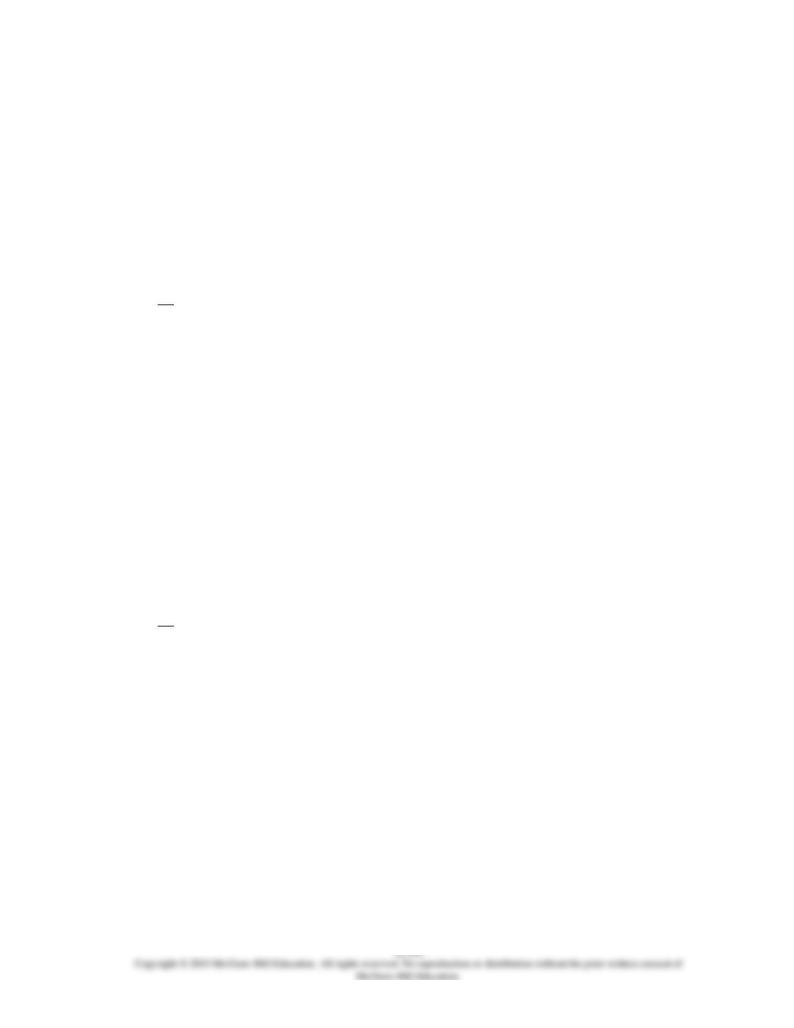
Topic: Economic Effects of Monopoly
100.
The economic incentive for price discrimination is based upon:
A.
Prejudices of business managers
B.
Differences among sellers' costs
C.
A desire to evade antitrust legislation
D.
Differences among buyers' elasticities of demand
AACSB: Analytic
Accessibility: Keyboard Navigation
Blooms: Remember
Difficulty: 1 Easy
Learning Objective: 12-06 Describe why a monopolist might prefer to charge different prices in different markets.
Topic: Price Discrimination
101.
To practice long-run price discrimination, a monopolist must:
A.
Be a natural monopoly
B.
Charge one price to all buyers
C.
Permit the resale of the product by the original buyers
D.
Be able to separate buyers into different markets with different price
elasticities
AACSB: Analytic
Accessibility: Keyboard Navigation
Blooms: Remember
Difficulty: 1 Easy
Learning Objective: 12-06 Describe why a monopolist might prefer to charge different prices in different markets.
Topic: Price Discrimination

102.
Which of the following statements is true of price discrimination?
AACSB: Analytic
Accessibility: Keyboard Navigation
Blooms: Understand
Difficulty: 2 Medium
Learning Objective: 12-06 Describe why a monopolist might prefer to charge different prices in different markets.
Topic: Price Discrimination
103.
Which is
not
true of price discrimination?
AACSB: Analytic
Accessibility: Keyboard Navigation
Blooms: Remember
Difficulty: 2 Medium
Learning Objective: 12-06 Describe why a monopolist might prefer to charge different prices in different markets.
Topic: Price Discrimination
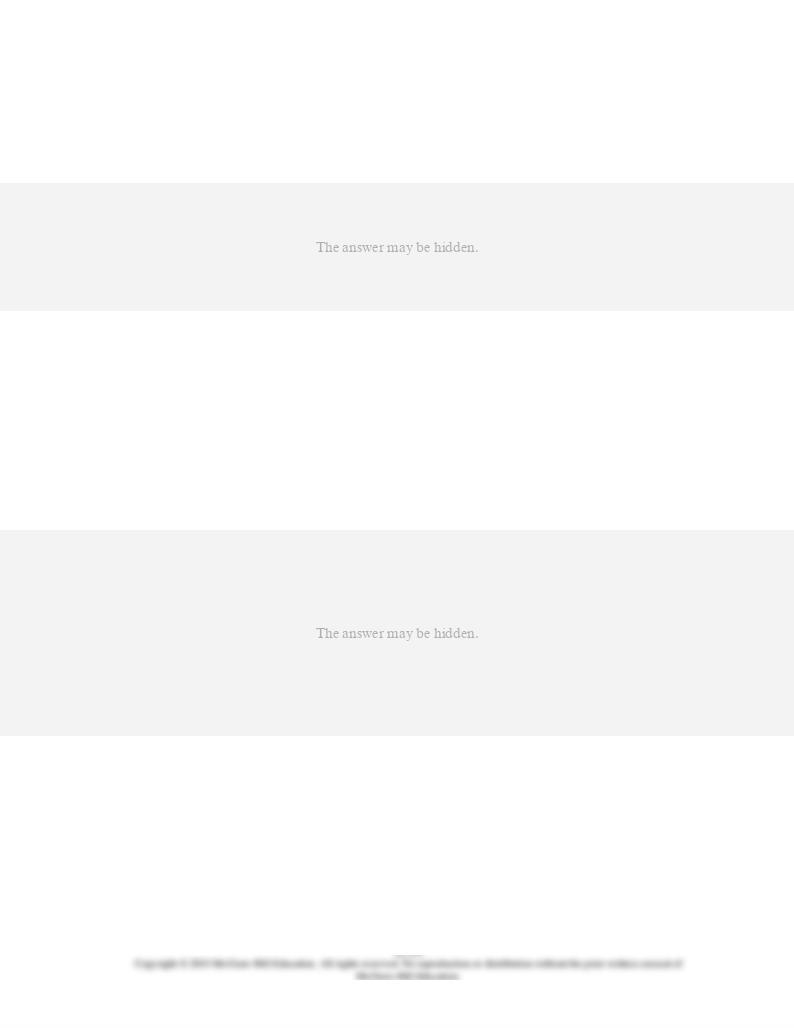
104.
Which would definitely
not
be an example of price discrimination?
AACSB: Reflective Thinking
Accessibility: Keyboard Navigation
Blooms: Apply
Difficulty: 2 Medium
Learning Objective: 12-06 Describe why a monopolist might prefer to charge different prices in different markets.
Topic: Price Discrimination
105.
Which case below best represents a case of price discrimination?
AACSB: Reflective Thinking
Accessibility: Keyboard Navigation
Blooms: Apply
Difficulty: 2 Medium
Learning Objective: 12-06 Describe why a monopolist might prefer to charge different prices in different markets.
Topic: Price Discrimination

106.
Which is the best example of price discrimination?
AACSB: Reflective Thinking
Accessibility: Keyboard Navigation
Blooms: Apply
Difficulty: 2 Medium
Learning Objective: 12-06 Describe why a monopolist might prefer to charge different prices in different markets.
Topic: Price Discrimination
107.
Which is true of a price discriminating pure monopolist?
AACSB: Analytic
Accessibility: Keyboard Navigation
Blooms: Remember
Difficulty: 1 Easy
Learning Objective: 12-06 Describe why a monopolist might prefer to charge different prices in different markets.
Topic: Price Discrimination

108.
Price discrimination is more common in service industries because:
AACSB: Analytic
Accessibility: Keyboard Navigation
Blooms: Apply
Difficulty: 2 Medium
Learning Objective: 12-06 Describe why a monopolist might prefer to charge different prices in different markets.
Topic: Price Discrimination
109.
A price-discriminating monopolist will follow a system where:
AACSB: Analytic
Accessibility: Keyboard Navigation
Blooms: Remember
Difficulty: 2 Medium
Learning Objective: 12-06 Describe why a monopolist might prefer to charge different prices in different markets.
Topic: Price Discrimination
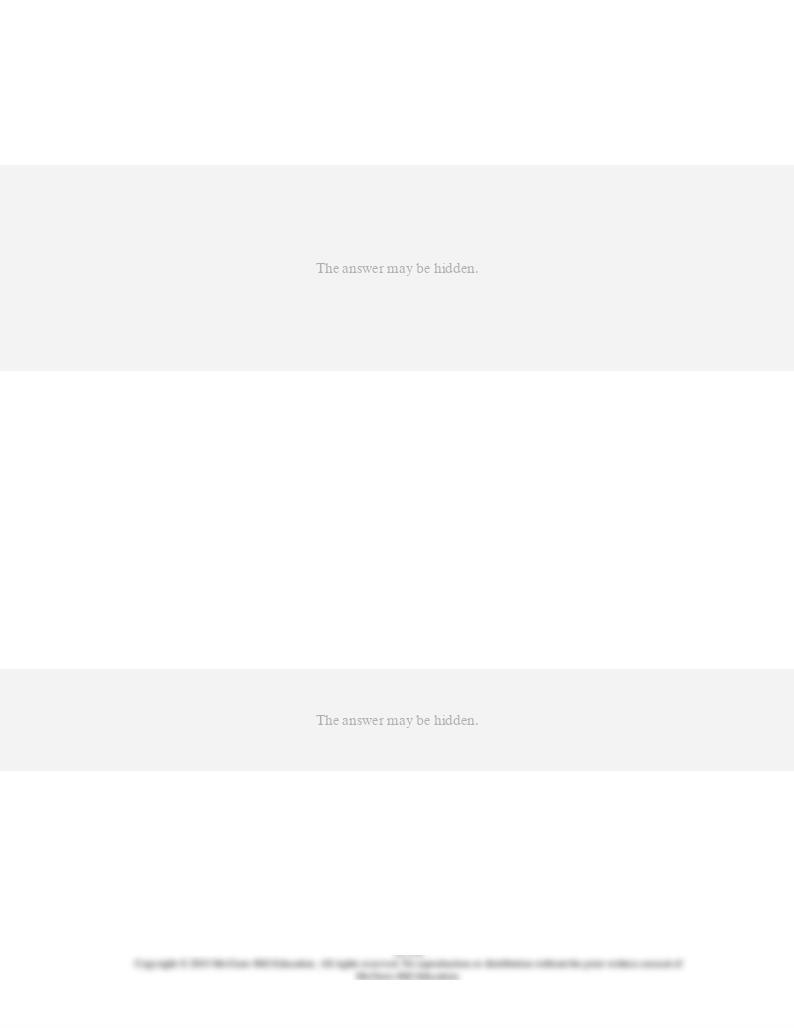
110.
Consumers who clip and redeem discount coupons:
AACSB: Reflective Thinking
Accessibility: Keyboard Navigation
Blooms: Understand
Difficulty: 2 Medium
Learning Objective: 12-06 Describe why a monopolist might prefer to charge different prices in different markets.
Topic: Price Discrimination
111.
Electric companies generally practice price discrimination and charge
higher prices for electricity used for illumination and lower prices for
electricity used for heat. These lower prices for electric heating result
primarily from:
AACSB: Reflective Thinking
Accessibility: Keyboard Navigation
Blooms: Apply
Difficulty: 3 Hard
Learning Objective: 12-06 Describe why a monopolist might prefer to charge different prices in different markets.
Topic: Price Discrimination

112.
If a price-discriminating monopolist sells the same product in two markets
but charges a higher price in market X and a lower price in market Y, the
pricing difference indicates that demand is:
AACSB: Analytic
Accessibility: Keyboard Navigation
Blooms: Apply
Difficulty: 3 Hard
Learning Objective: 12-06 Describe why a monopolist might prefer to charge different prices in different markets.
Topic: Price Discrimination
113.
Price discrimination for concessions at ball parks is not applied to adults
and children because:
AACSB: Reflective Thinking
Accessibility: Keyboard Navigation
Blooms: Apply
Difficulty: 2 Medium
Learning Objective: 12-06 Describe why a monopolist might prefer to charge different prices in different markets.
Topic: Price Discrimination

114.
Refer to the above cost and demand data for a pure monopolist. Suppose
that this monopoly is subjected to a regulatory commission. If the
commission seeks to achieve the most efficient allocation of resources for
this industry, it should set the socially optimal price at:
AACSB: Analytic
Blooms: Apply
Difficulty: 3 Hard
Learning Objective: 12-07 Distinguish between the monopoly price; the socially optimal price; and the fair-return price of
a government-regulated monopoly.
Topic: Regulated Monopoly

115.
One argument for having the government regulate natural monopolies is
that without regulation:
AACSB: Analytic
Blooms: Remember
Difficulty: 2 Medium
Learning Objective: 12-07 Distinguish between the monopoly price; the socially optimal price; and the fair-return price of
a government-regulated monopoly.
Topic: Regulated Monopoly
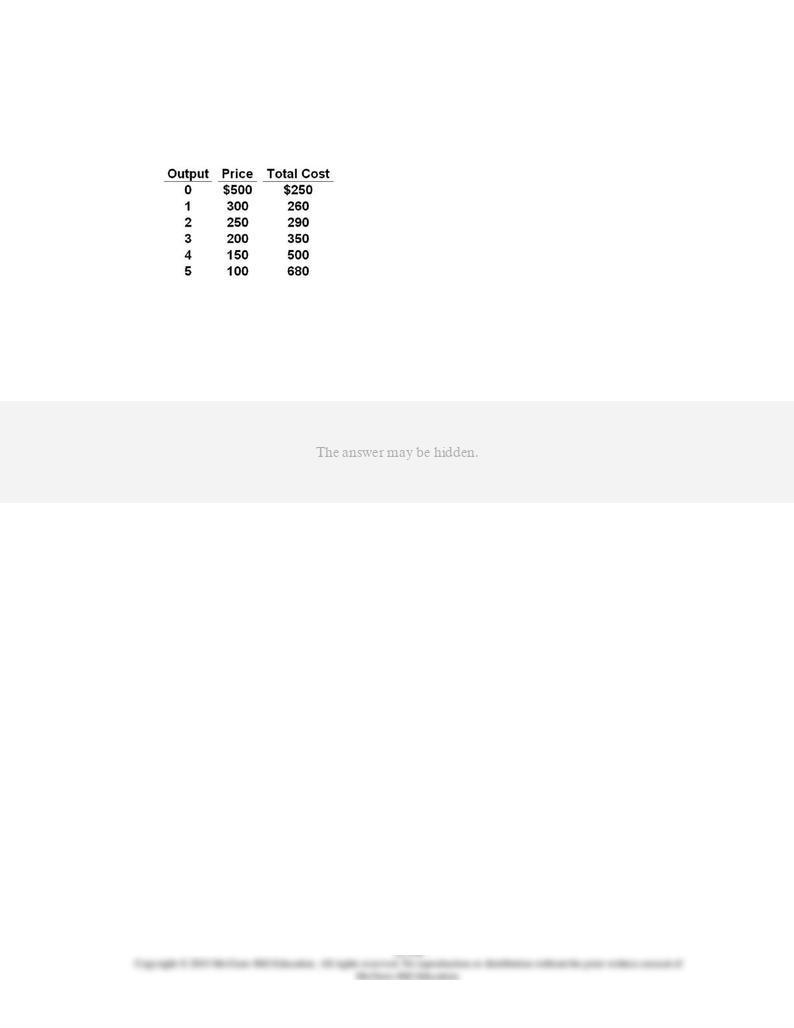
116.
The following question is based on the demand and cost data for a pure
monopolist given in the table below.
Refer to the above table for a monopolist. A non-discriminating monopolist
would maximize profits at a price and quantity of:
AACSB: Analytic
Blooms: Apply
Difficulty: 2 Medium
Learning Objective: 12-07 Distinguish between the monopoly price; the socially optimal price; and the fair-return price of
a government-regulated monopoly.
Topic: Regulated Monopoly
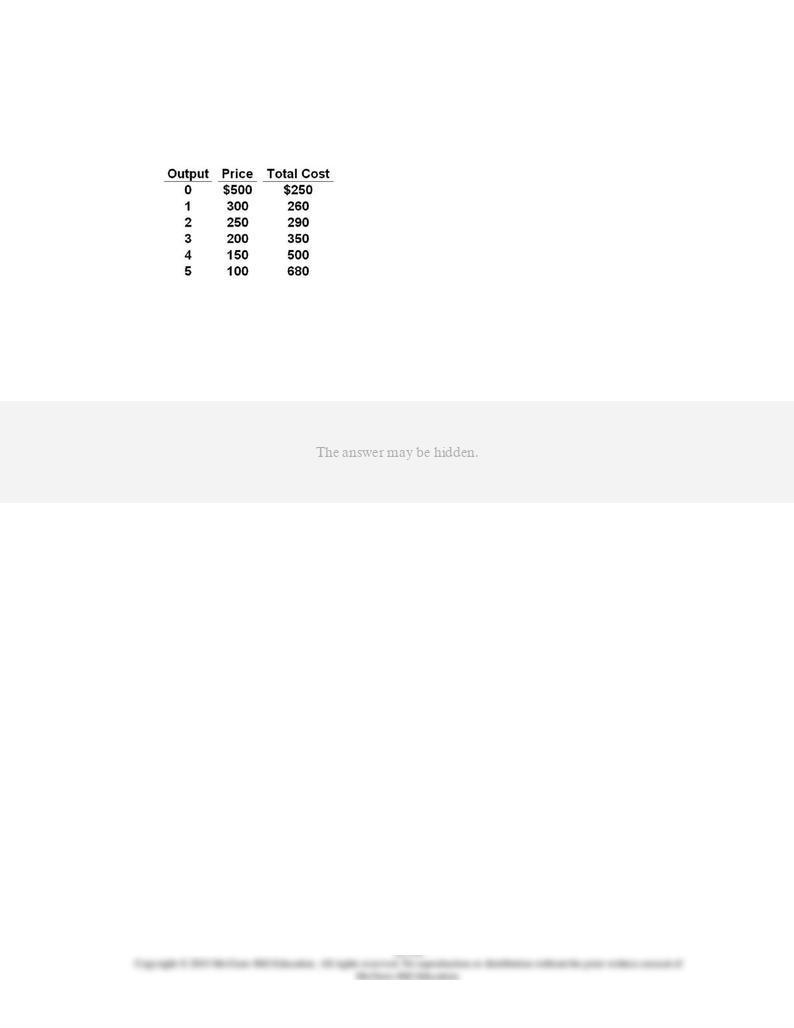
117.
The following question is based on the demand and cost data for a pure
monopolist given in the table below.
Refer to the above table for a monopolist. A non-discriminating monopolist
would earn maximum profits of:
AACSB: Analytic
Blooms: Analyze
Difficulty: 3 Hard
Learning Objective: 12-07 Distinguish between the monopoly price; the socially optimal price; and the fair-return price of
a government-regulated monopoly.
Topic: Regulated Monopoly
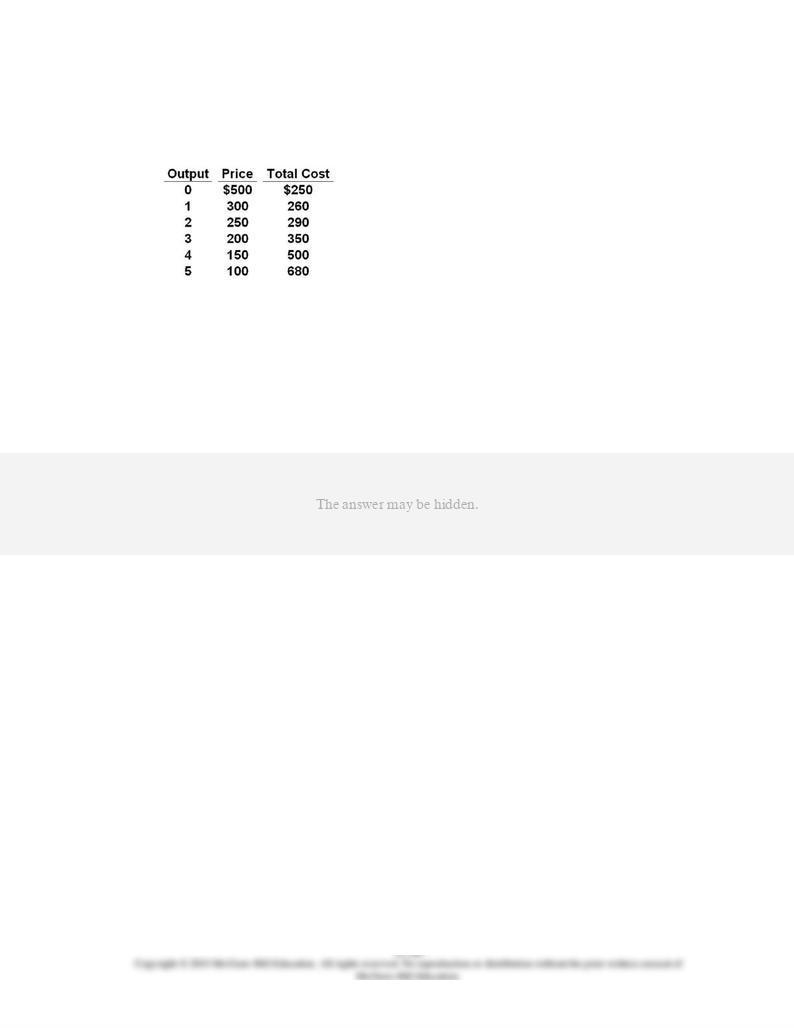
118.
The following question is based on the demand and cost data for a pure
monopolist given in the table below.
Refer to the above table for a monopolist. If the monopolist perfectly price-
discriminated and sold each unit of the product at the maximum price the
buyer of that unit would be willing to pay, and if the monopolist sold 4
units, then total revenue would be:
AACSB: Analytic
Blooms: Analyze
Difficulty: 3 Hard
Learning Objective: 12-07 Distinguish between the monopoly price; the socially optimal price; and the fair-return price of
a government-regulated monopoly.
Topic: Regulated Monopoly

119.
The following question is based on the demand and cost data for a pure
monopolist given in the table below.
Refer to the above table for a monopolist. If the monopolist perfectly price-
discriminated and sold each unit of the product at the maximum price the
buyer of that unit would be willing to pay, and if the monopolist sold 4
units, then total profits would be:
AACSB: Analytic
Blooms: Analyze
Difficulty: 3 Hard
Learning Objective: 12-07 Distinguish between the monopoly price; the socially optimal price; and the fair-return price of
a government-regulated monopoly.
Topic: Regulated Monopoly

120.
The following question is based on the demand and cost data for a pure
monopolist given in the table below.
Refer to the above table. If the monopolist were forced to produce the
socially optimal output through the imposition of a ceiling price, the ceiling
price would have to be set at:
AACSB: Analytic
Blooms: Apply
Difficulty: 3 Hard
Learning Objective: 12-07 Distinguish between the monopoly price; the socially optimal price; and the fair-return price of
a government-regulated monopoly.
Topic: Regulated Monopoly
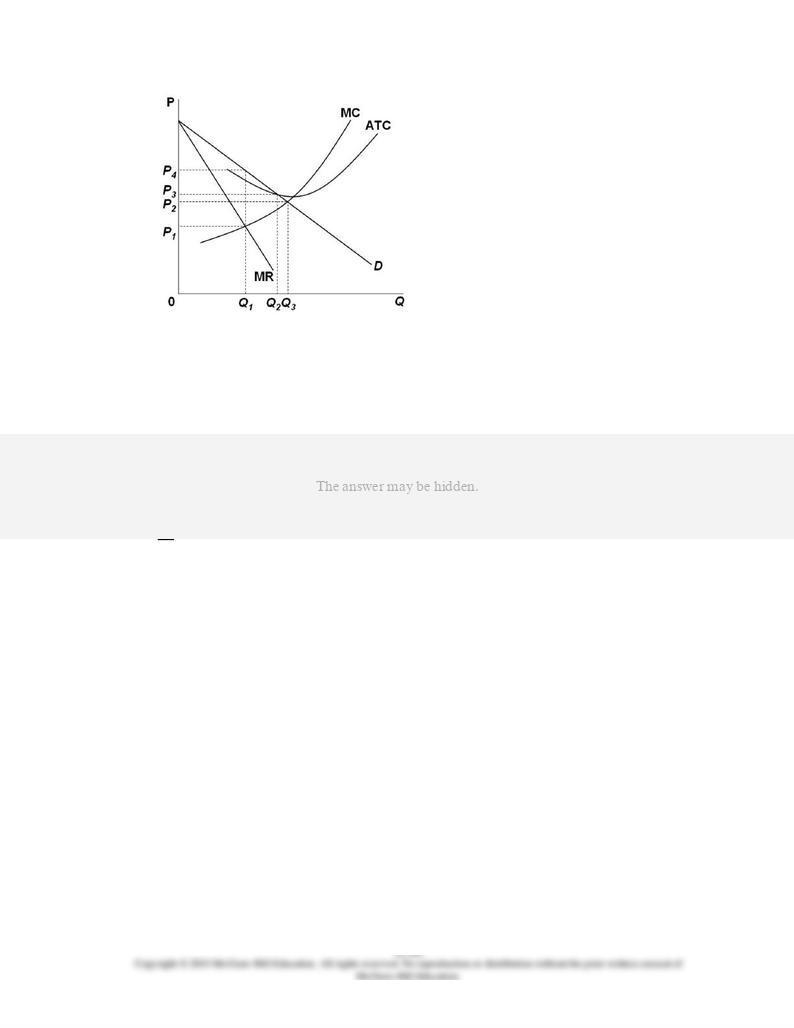
121.
Refer to the above graph for a pure monopoly. A profit-maximizing
monopolist would set what price and quantity levels in the short run?
AACSB: Analytic
Blooms: Apply
Difficulty: 2 Medium
Learning Objective: 12-07 Distinguish between the monopoly price; the socially optimal price; and the fair-return price of
a government-regulated monopoly.
Topic: Regulated Monopoly
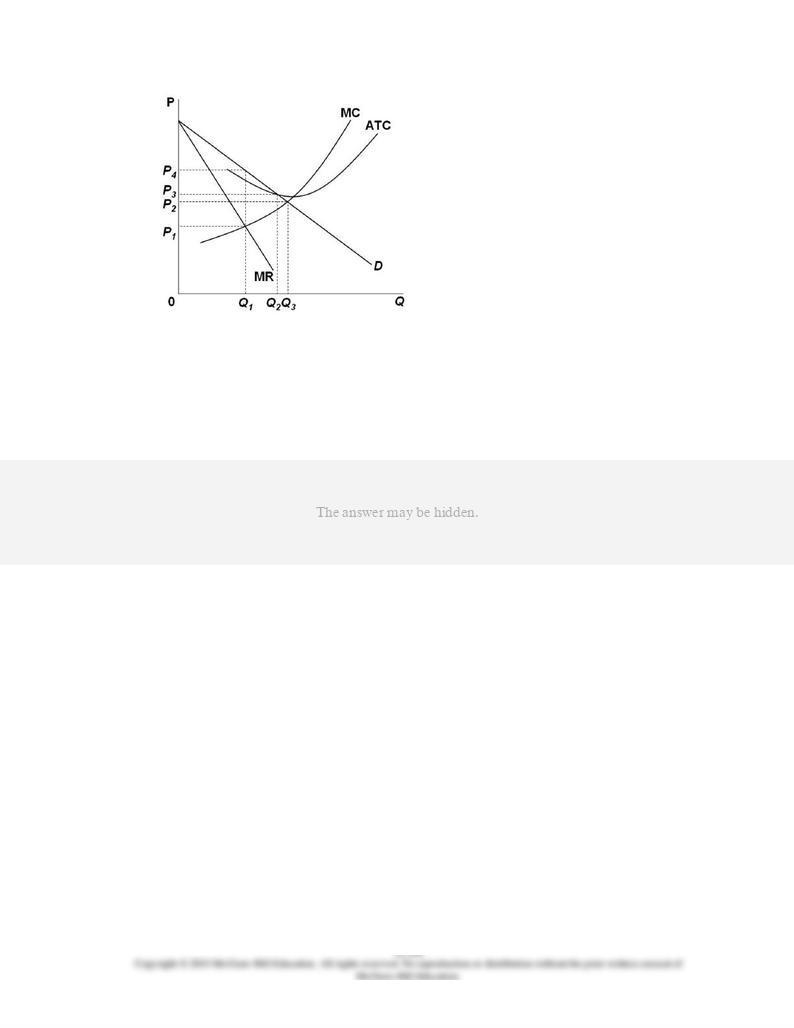
122.
Refer to the above graph for a pure monopoly. If the government regulated
the monopoly and made the firm set a fair-return price, what price and
quantity levels would we observe in the short run?
AACSB: Analytic
Blooms: Apply
Difficulty: 2 Medium
Learning Objective: 12-07 Distinguish between the monopoly price; the socially optimal price; and the fair-return price of
a government-regulated monopoly.
Topic: Regulated Monopoly

123.
Refer to the above graph for a pure monopoly. If the government regulated
the monopoly and made it produce the level of output that would achieve
allocative efficiency, what price and quantity levels would we observe in
the short run?
AACSB: Analytic
Blooms: Apply
Difficulty: 2 Medium
Learning Objective: 12-07 Distinguish between the monopoly price; the socially optimal price; and the fair-return price of
a government-regulated monopoly.
Topic: Regulated Monopoly
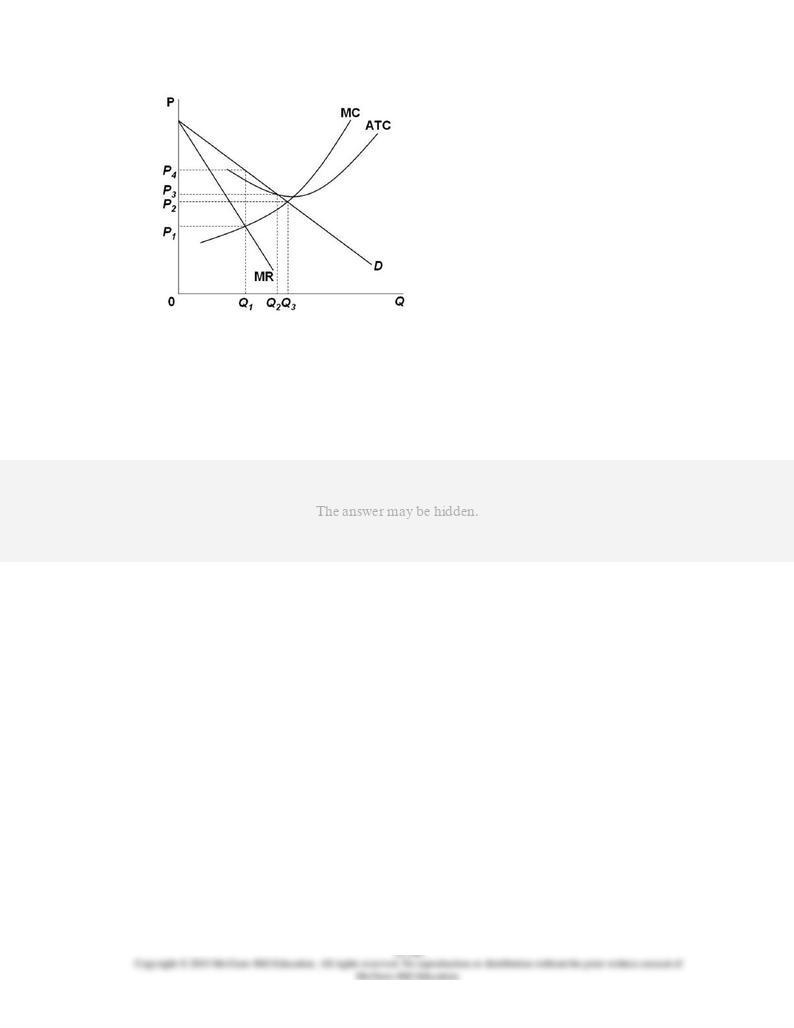
124.
Refer to the above graph for a pure monopoly. If the government regulated
the monopoly and made it charge the socially optimal price, this price
would be:
AACSB: Analytic
Blooms: Apply
Difficulty: 3 Hard
Learning Objective: 12-07 Distinguish between the monopoly price; the socially optimal price; and the fair-return price of
a government-regulated monopoly.
Topic: Regulated Monopoly
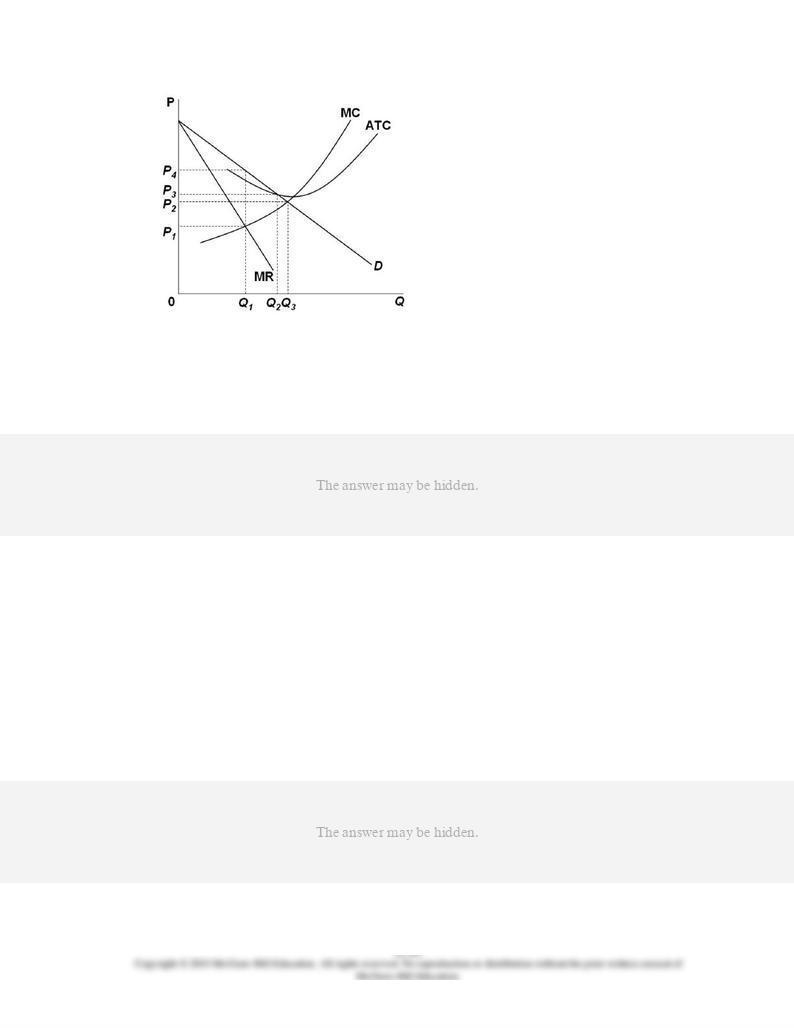
125.
Refer to the above graph for a pure monopoly. Which pricing model would
the monopolist ______ to earn positive economic profits?
AACSB: Analytic
Blooms: Analyze
Difficulty: 3 Hard
Learning Objective: 12-07 Distinguish between the monopoly price; the socially optimal price; and the fair-return price of
a government-regulated monopoly.
Topic: Regulated Monopoly
126.
The problem with socially-optimal pricing regulation of a natural monopoly
is that:
AACSB: Reflective Thinking
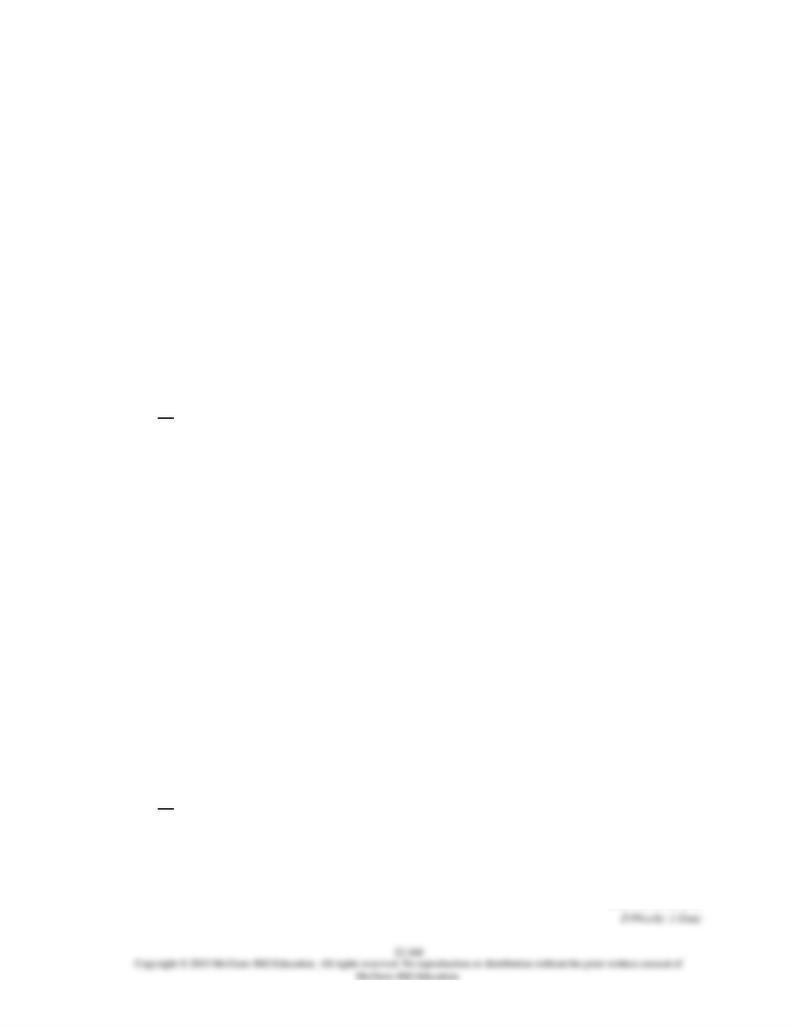
Accessibility: Keyboard Navigation
Blooms: Understand
Difficulty: 3 Hard
Learning Objective: 12-07 Distinguish between the monopoly price; the socially optimal price; and the fair-return price of
a government-regulated monopoly.
Topic: Regulated Monopoly
127.
The problem with adopting a fair-return pricing policy for a natural
monopoly is that:
A.
Economic profits will be positive
B.
Economic profits will be negative
C.
It is not productively efficient
D.
It is not allocatively efficient
AACSB: Reflective Thinking
Accessibility: Keyboard Navigation
Blooms: Understand
Difficulty: 2 Medium
Learning Objective: 12-07 Distinguish between the monopoly price; the socially optimal price; and the fair-return price of
a government-regulated monopoly.
Topic: Regulated Monopoly
128.
An argument for making regulated monopolies adopt marginal cost pricing
is that this would:
A.
Increase productive efficiency by making price equal average cost
B.
Benefit higher income groups by making monopoly products more
affordable
C.
Increase managerial incentives to reduce employment and production
D.
Make the marginal cost equal to society's valuation of the marginal
benefit
AACSB: Analytic
Accessibility: Keyboard Navigation
Blooms: Remember

Learning Objective: 12-07 Distinguish between the monopoly price; the socially optimal price; and the fair-return price of
129.
With a natural monopoly, the fair return price:
A.
Is allocatively efficient; the socially optimal price is allocatively
inefficient
B.
Is allocatively inefficient; the socially optimal price is allocatively
efficient
C.
And the socially optimal price are both allocatively inefficient
D.
And the socially optimal price are both allocatively efficient
AACSB: Analytic
Accessibility: Keyboard Navigation
Blooms: Remember

130.
What is the meaning of the phrase "dilemma of regulation"?
AACSB: Analytic
Accessibility: Keyboard Navigation
Blooms: Remember
Difficulty: 2 Medium
Learning Objective: 12-07 Distinguish between the monopoly price; the socially optimal price; and the fair-return price of
a government-regulated monopoly.
Topic: Regulated Monopoly
131.
Google gained its monopoly power in the market for internet-search service
because it:
AACSB: Reflective Thinking
Accessibility: Keyboard Navigation
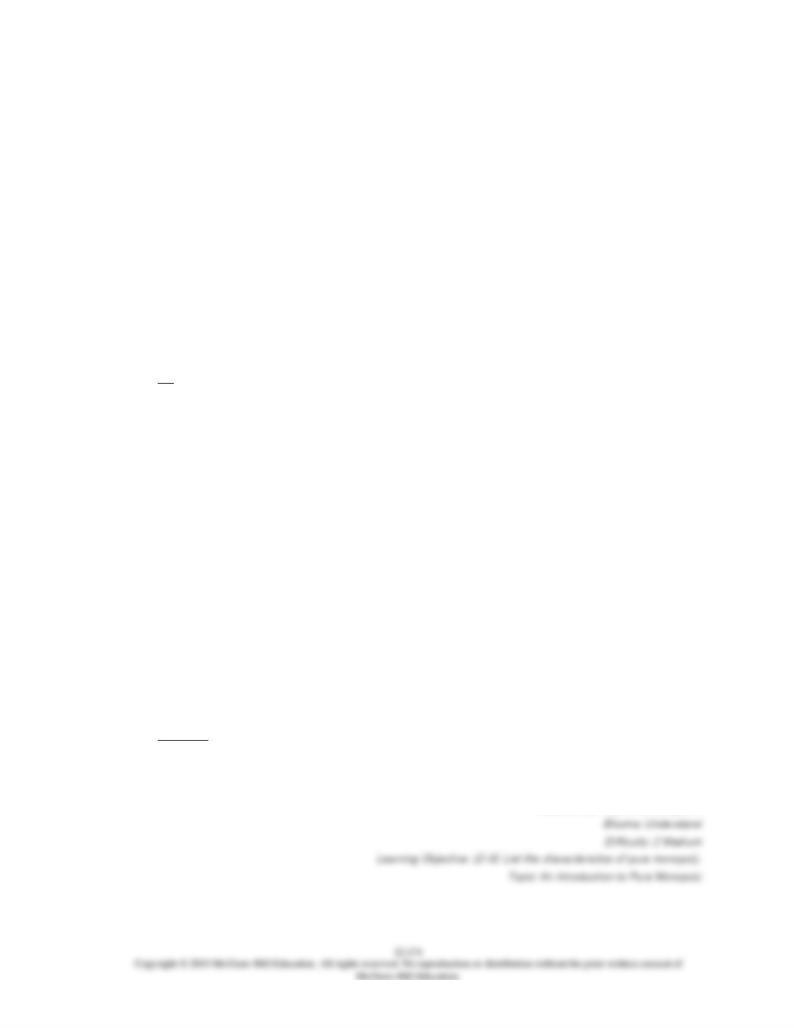
Blooms: Apply
Difficulty: 2 Medium
Learning Objective: 12-02 List and explain the barriers to entry that shield pure monopolies from competition.
Topic: Barriers to Entry
132.
Google and Amazon have enjoyed barriers to entry in their respective
markets due to the following,
except
:
A.
Network effects among users
B.
Economies of scale in operations
C.
Loyalty and familiarity of consumers
D.
Government licensing and regulation
AACSB: Reflective Thinking
Accessibility: Keyboard Navigation
Blooms: Apply
Difficulty: 2 Medium
Learning Objective: 12-02 List and explain the barriers to entry that shield pure monopolies from competition.
Topic: Barriers to Entry
True / False Questions
133.
"Price maker" means that a monopoly can decide whatever price it wants
to, in order to sell a specific given quantity of its product.
FALSE
AACSB: Analytic
AACSB: Communication
Accessibility: Keyboard Navigation
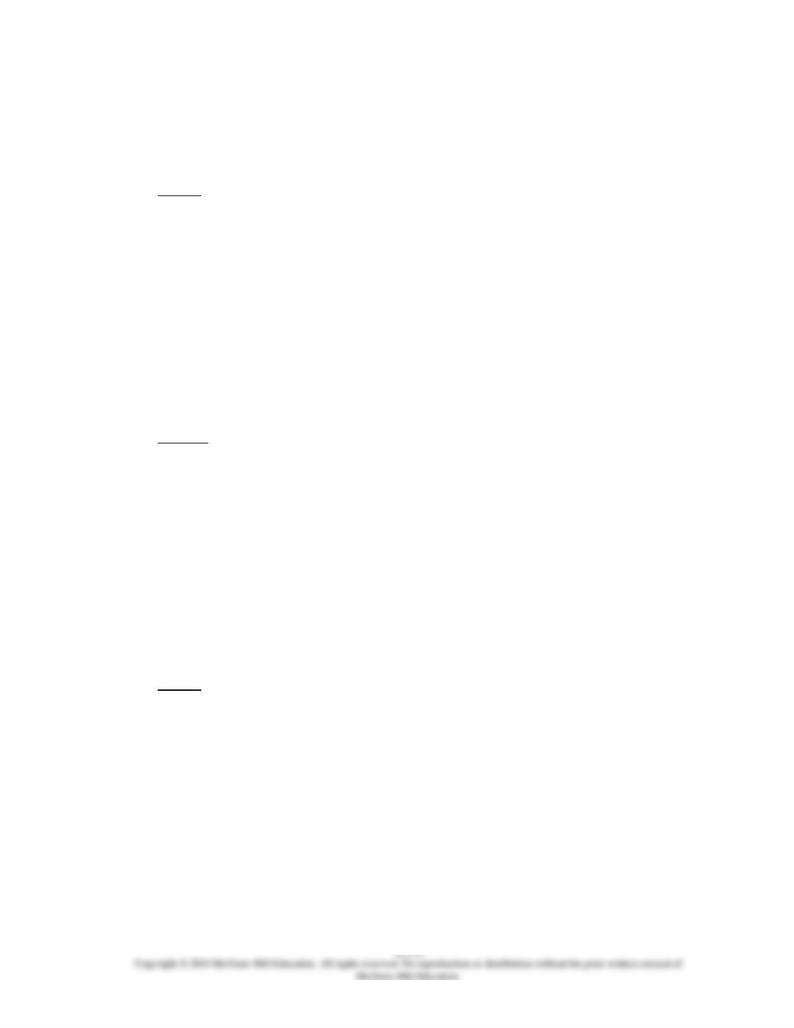
134.
The government may create barriers to entry that serve to foster monopoly
power of firms.
TRUE
AACSB: Analytic
Accessibility: Keyboard Navigation
Blooms: Remember
Difficulty: 1 Easy
Learning Objective: 12-02 List and explain the barriers to entry that shield pure monopolies from competition.
Topic: Barriers to Entry
135.
A patent for a new product or a new business process is typically granted
for a hundred years.
FALSE
AACSB: Analytic
Accessibility: Keyboard Navigation
Blooms: Remember
Difficulty: 1 Easy
Learning Objective: 12-02 List and explain the barriers to entry that shield pure monopolies from competition.
Topic: Barriers to Entry
136.
A monopolist can use its pricing strategy as a barrier to entry by other
firms.
TRUE
AACSB: Analytic
Accessibility: Keyboard Navigation
Blooms: Remember
Difficulty: 1 Easy
Learning Objective: 12-02 List and explain the barriers to entry that shield pure monopolies from competition.
Topic: Barriers to Entry
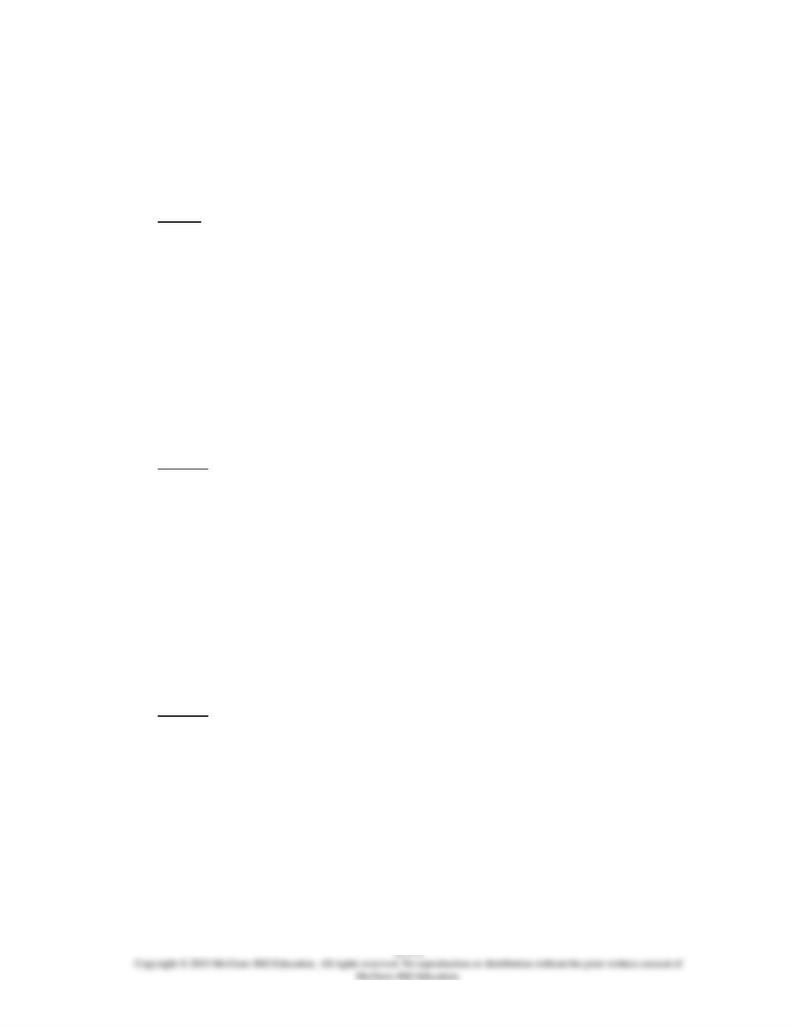
137.
A firm sells 99 units of output when price equals $10, and 100 units of
output when price equals $9. Its marginal revenue for the 100th unit of
output is negative.
TRUE
AACSB: Analytic
Accessibility: Keyboard Navigation
Blooms: Apply
Difficulty: 2 Medium
Learning Objective: 12-03 Explain how demand is seen by a pure monopoly.
Topic: Monopoly Demand
138.
The monopolist's demand curve is more elastic than the industry demand
curve.
FALSE
AACSB: Analytic
Accessibility: Keyboard Navigation
Blooms: Remember
Difficulty: 1 Easy
Learning Objective: 12-03 Explain how demand is seen by a pure monopoly.
Topic: Monopoly Demand
139.
At the inelastic portion of a monopolist's demand curve, the marginal
revenue of each extra unit of output is positive.
FALSE
AACSB: Analytic
Accessibility: Keyboard Navigation
Blooms: Remember
Difficulty: 1 Easy
Learning Objective: 12-03 Explain how demand is seen by a pure monopoly.
Topic: Monopoly Demand

140.
As a monopolist lowers the price of its product from a high level, it finds
that its total revenue may at first increase and then, below a certain price,
its total revenue begins to decrease.
TRUE
AACSB: Analytic
Accessibility: Keyboard Navigation
Blooms: Apply
Difficulty: 2 Medium
Learning Objective: 12-03 Explain how demand is seen by a pure monopoly.
Topic: Monopoly Demand
141.
A monopolist will avoid setting a price in the elastic segment of the
demand curve and prefer to set the price in the inelastic segment.
FALSE
AACSB: Analytic
Accessibility: Keyboard Navigation
Blooms: Understand
Difficulty: 2 Medium
Learning Objective: 12-03 Explain how demand is seen by a pure monopoly.
Topic: Monopoly Demand
142.
In order to maximize profits, the monopolist will produce the output level
where MR = MC and charge a price equal to MR and MC.
FALSE
AACSB: Analytic
Accessibility: Keyboard Navigation
Blooms: Understand
Difficulty: 2 Medium
Learning Objective: 12-04 Explain how a pure monopoly sets its profit-maximizing output and price.
Topic: Output and Price Determination
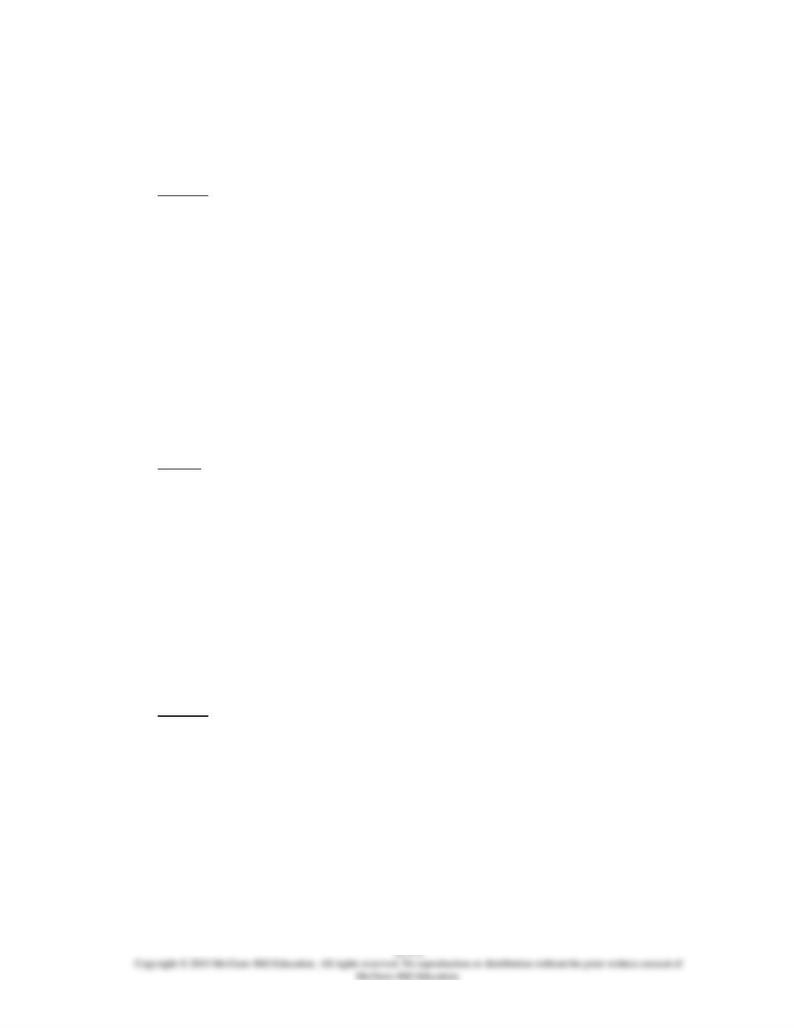
143.
A monopolist, being the sole seller in a market, is assured of positive
economic profits.
FALSE
AACSB: Analytic
Accessibility: Keyboard Navigation
Blooms: Understand
Difficulty: 2 Medium
Learning Objective: 12-04 Explain how a pure monopoly sets its profit-maximizing output and price.
Topic: Output and Price Determination
144.
If a monopolist finds itself operating in the inelastic portion of its demand
curve, then it should never lower its price because doing so would reduce
its profits.
TRUE
AACSB: Analytic
Accessibility: Keyboard Navigation
Blooms: Analyze
Difficulty: 3 Hard
Learning Objective: 12-04 Explain how a pure monopoly sets its profit-maximizing output and price.
Topic: Output and Price Determination
145.
The supply curve for a monopolist is the upward-sloping portion of the
marginal cost curve that lies above the average variable cost curve.
FALSE
AACSB: Analytic
Accessibility: Keyboard Navigation
Blooms: Remember
Difficulty: 2 Medium
Learning Objective: 12-04 Explain how a pure monopoly sets its profit-maximizing output and price.
Topic: Output and Price Determination
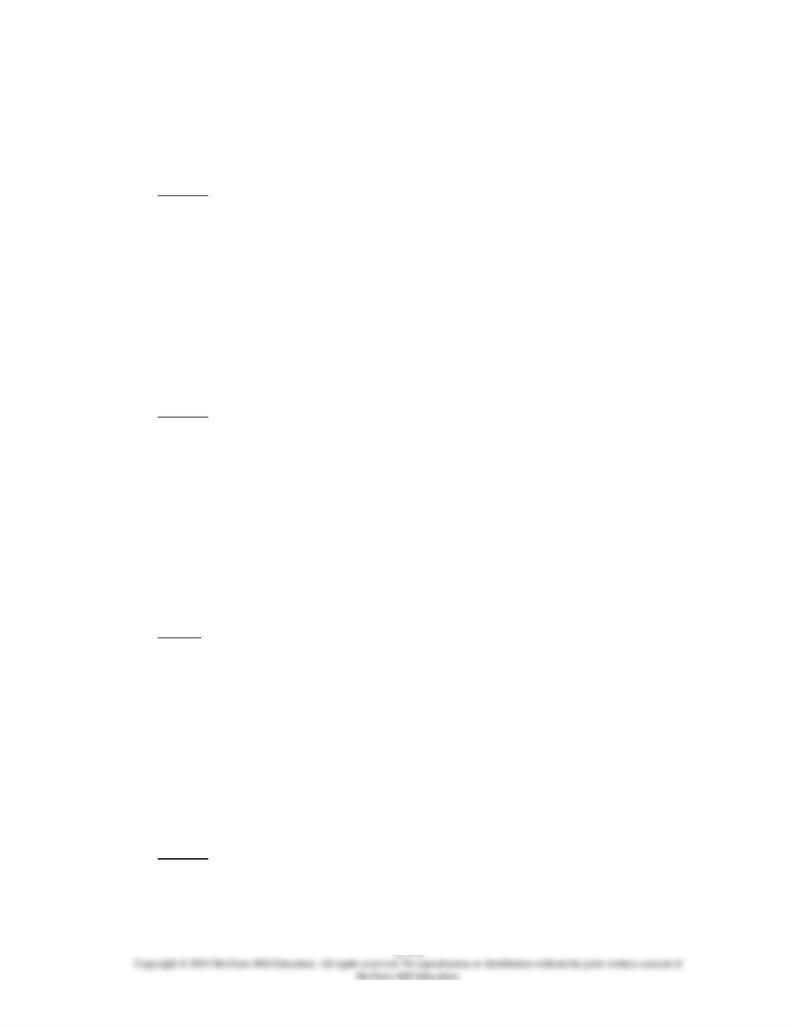
146.
For a monopolist maximum profits will occur when the gap between
average revenue (or price) and average cost is biggest.
FALSE
AACSB: Analytic
Accessibility: Keyboard Navigation
Blooms: Understand
Difficulty: 2 Medium
Learning Objective: 12-04 Explain how a pure monopoly sets its profit-maximizing output and price.
Topic: Output and Price Determination
147.
In the long run equilibrium, a monopolist will earn zero economic profits.
FALSE
AACSB: Analytic
Accessibility: Keyboard Navigation
Blooms: Remember
Difficulty: 1 Easy
Learning Objective: 12-05 Discuss the economic effects of monopoly.
Topic: Economic Effects of Monopoly
148.
In a monopoly at equilibrium, price is greater than marginal cost.
TRUE
AACSB: Analytic
Accessibility: Keyboard Navigation
Blooms: Remember
Difficulty: 2 Medium
Learning Objective: 12-05 Discuss the economic effects of monopoly.
Topic: Economic Effects of Monopoly
149.
A monopolist will try to charge the highest price that it can charge.
FALSE
AACSB: Analytic
Accessibility: Keyboard Navigation
Blooms: Remember

Difficulty: 3 Hard
Learning Objective: 12-05 Discuss the economic effects of monopoly.
Topic: Economic Effects of Monopoly
150.
In an unregulated monopoly at equilibrium, the output level is higher than
the economically efficient level.
FALSE
AACSB: Analytic
Accessibility: Keyboard Navigation
Blooms: Remember
Difficulty: 1 Easy
Learning Objective: 12-05 Discuss the economic effects of monopoly.
Topic: Economic Effects of Monopoly
151.
One of the economic effects of monopoly is an income transfer from
consumers to the firm.
TRUE
AACSB: Analytic
Accessibility: Keyboard Navigation
Blooms: Understand
Difficulty: 2 Medium
Learning Objective: 12-05 Discuss the economic effects of monopoly.
Topic: Economic Effects of Monopoly
152.
Price discrimination is not viable if consumers can resell the products they
purchase.
TRUE
AACSB: Analytic
Accessibility: Keyboard Navigation
Blooms: Remember
Difficulty: 2 Medium
Learning Objective: 12-06 Describe why a monopolist might prefer to charge different prices in different markets.
Topic: Price Discrimination
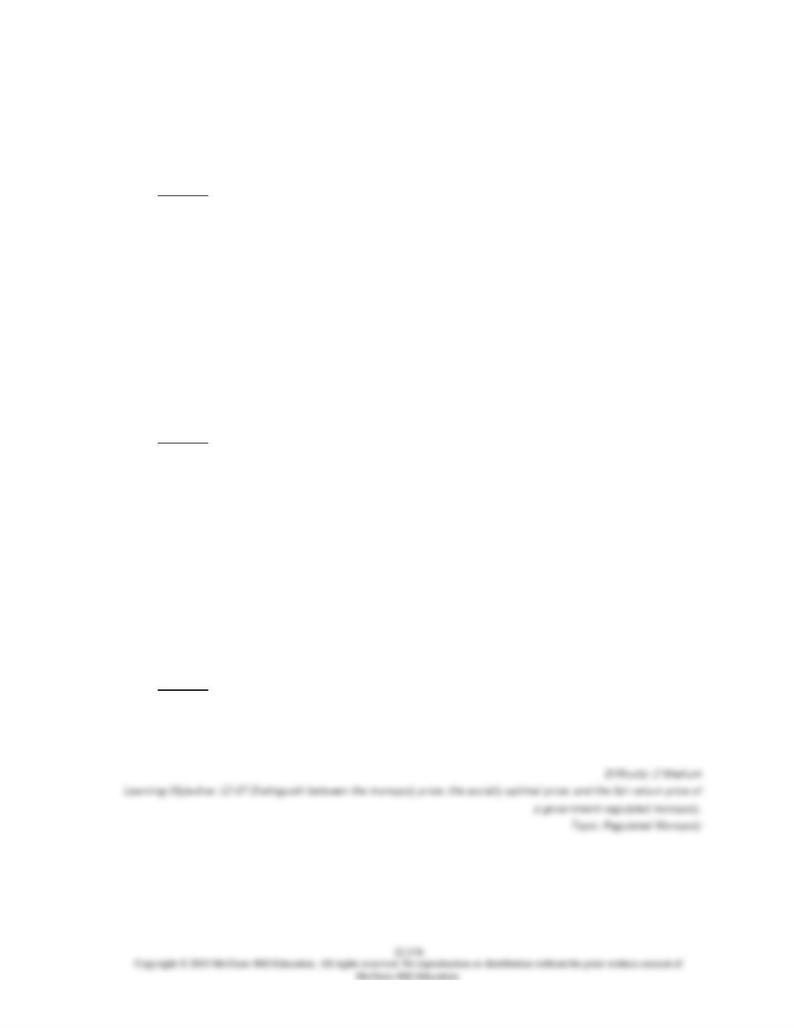
153.
In most cases, a monopolist practicing price discrimination will end up
earning less economic profits than a non-discriminating monopolist.
FALSE
AACSB: Analytic
Accessibility: Keyboard Navigation
Blooms: Remember
Difficulty: 3 Hard
Learning Objective: 12-06 Describe why a monopolist might prefer to charge different prices in different markets.
Topic: Price Discrimination
154.
A price-discriminating monopolist will set a higher price where demand is
more elastic and a lower price where demand is less elastic.
FALSE
AACSB: Analytic
Accessibility: Keyboard Navigation
Blooms: Apply
Difficulty: 3 Hard
Learning Objective: 12-06 Describe why a monopolist might prefer to charge different prices in different markets.
Topic: Price Discrimination
155.
In a natural monopoly case, the socially-optimal pricing policy rule will
often yield a higher price than the fair-return pricing rule.
FALSE
AACSB: Analytic
Accessibility: Keyboard Navigation
Blooms: Understand
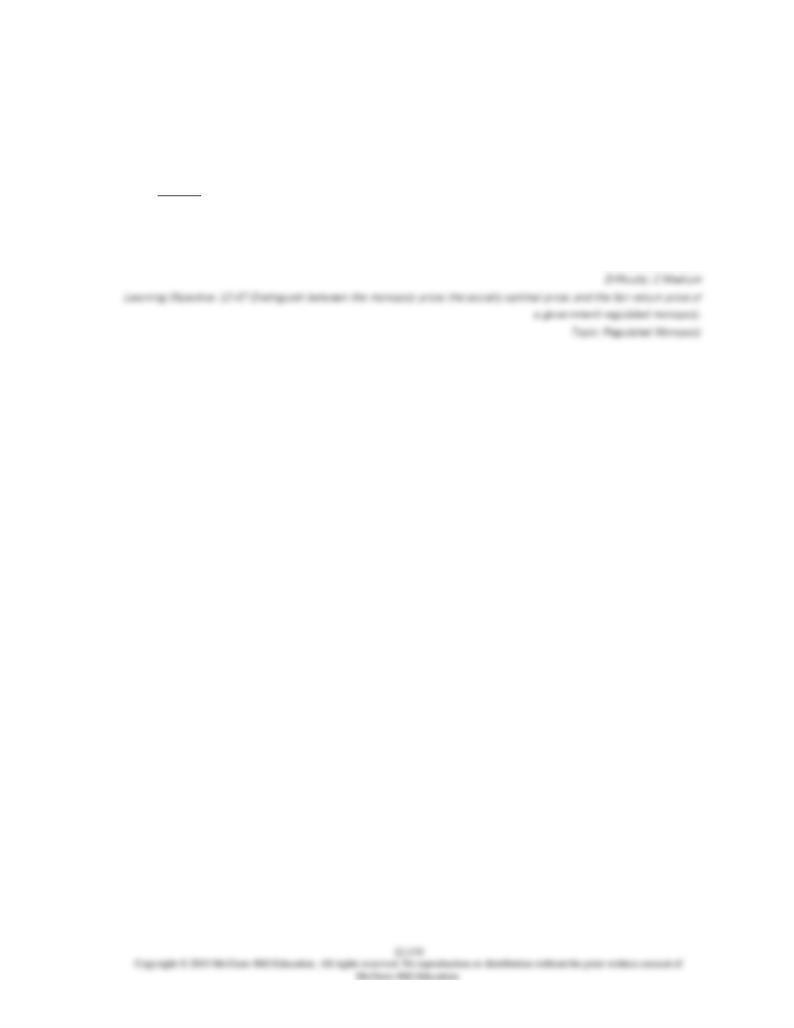
156.
In a natural monopoly case, the socially-optimal pricing policy rule will
often result in negative economic profits for the firm.
TRUE
AACSB: Analytic
Accessibility: Keyboard Navigation
Blooms: Understand